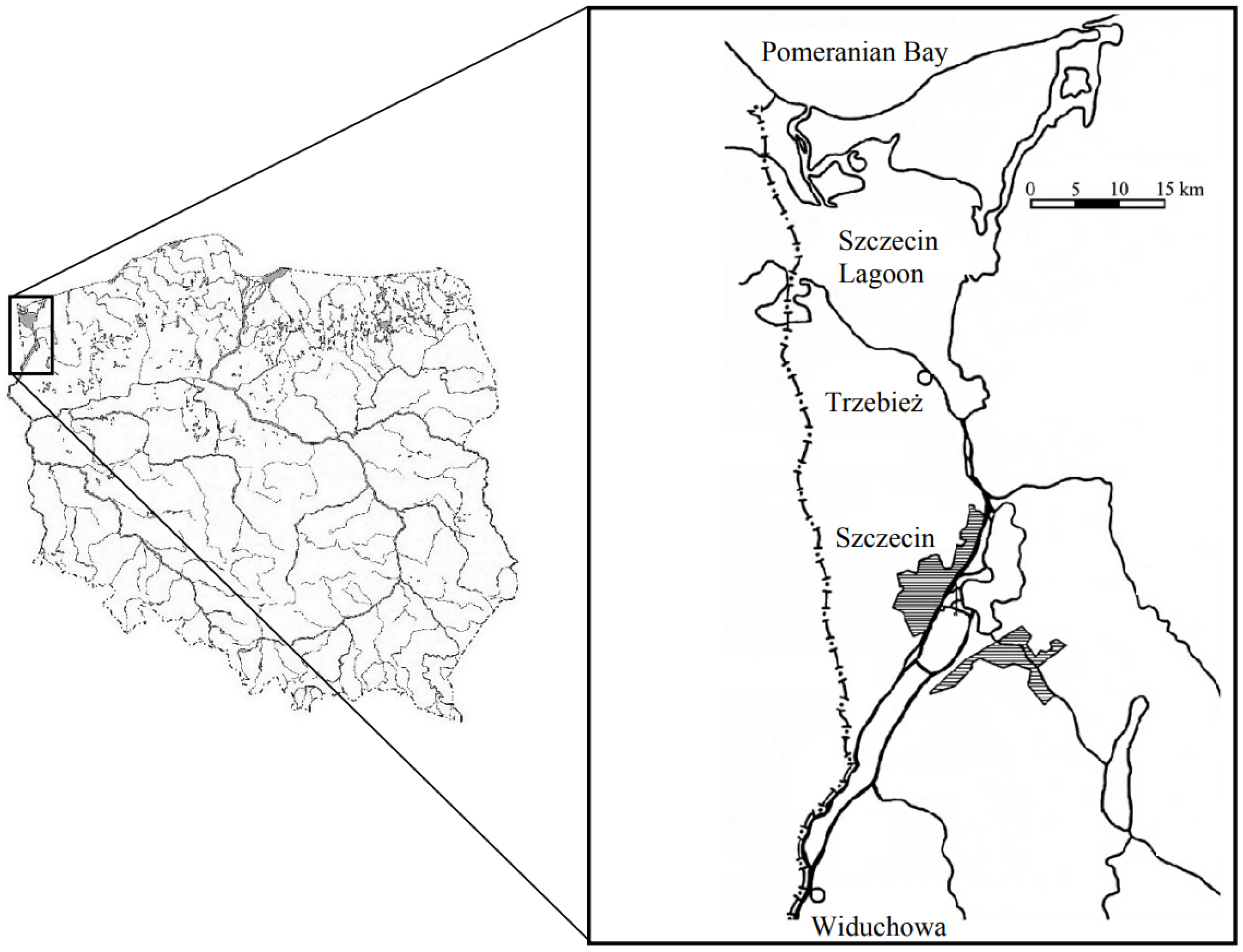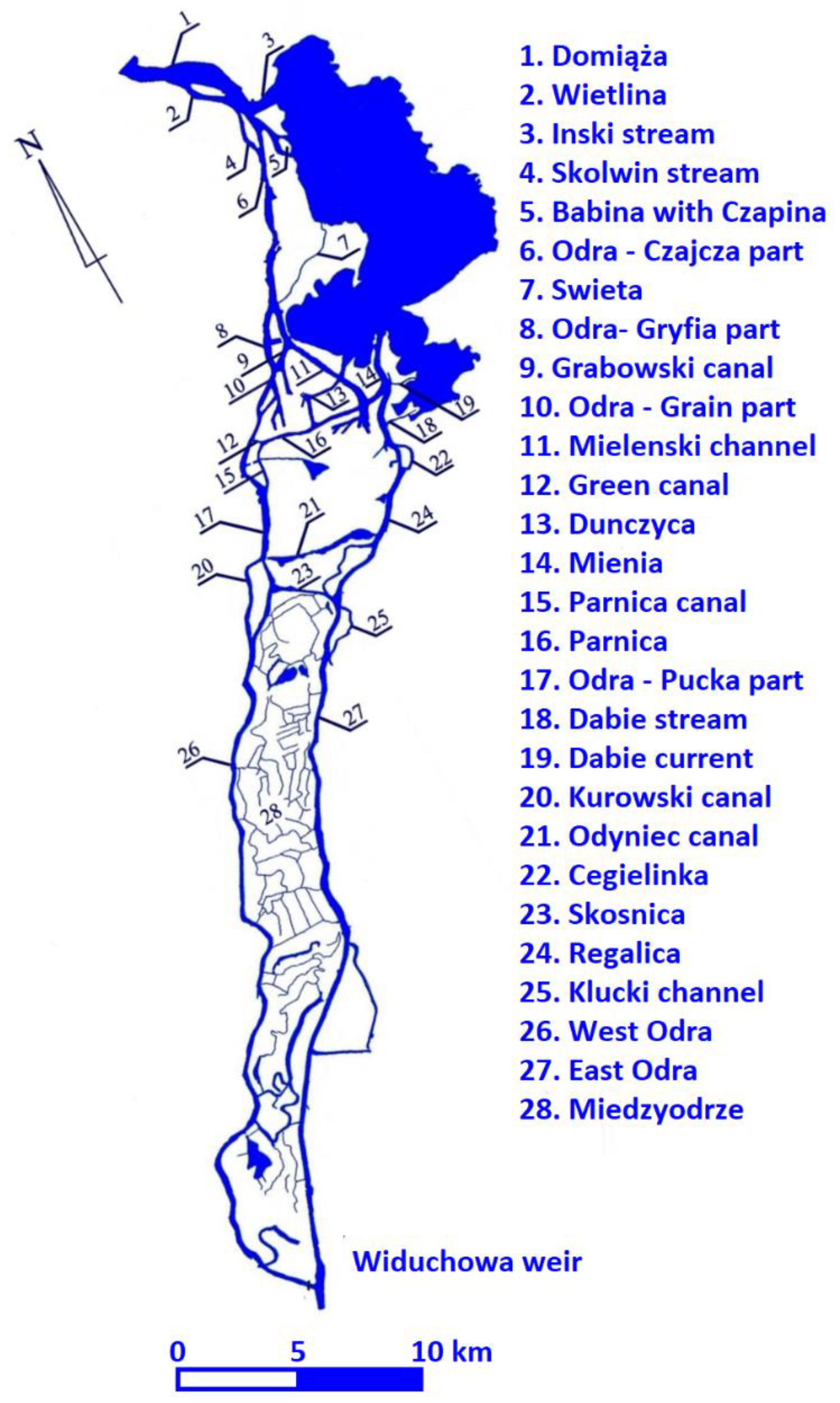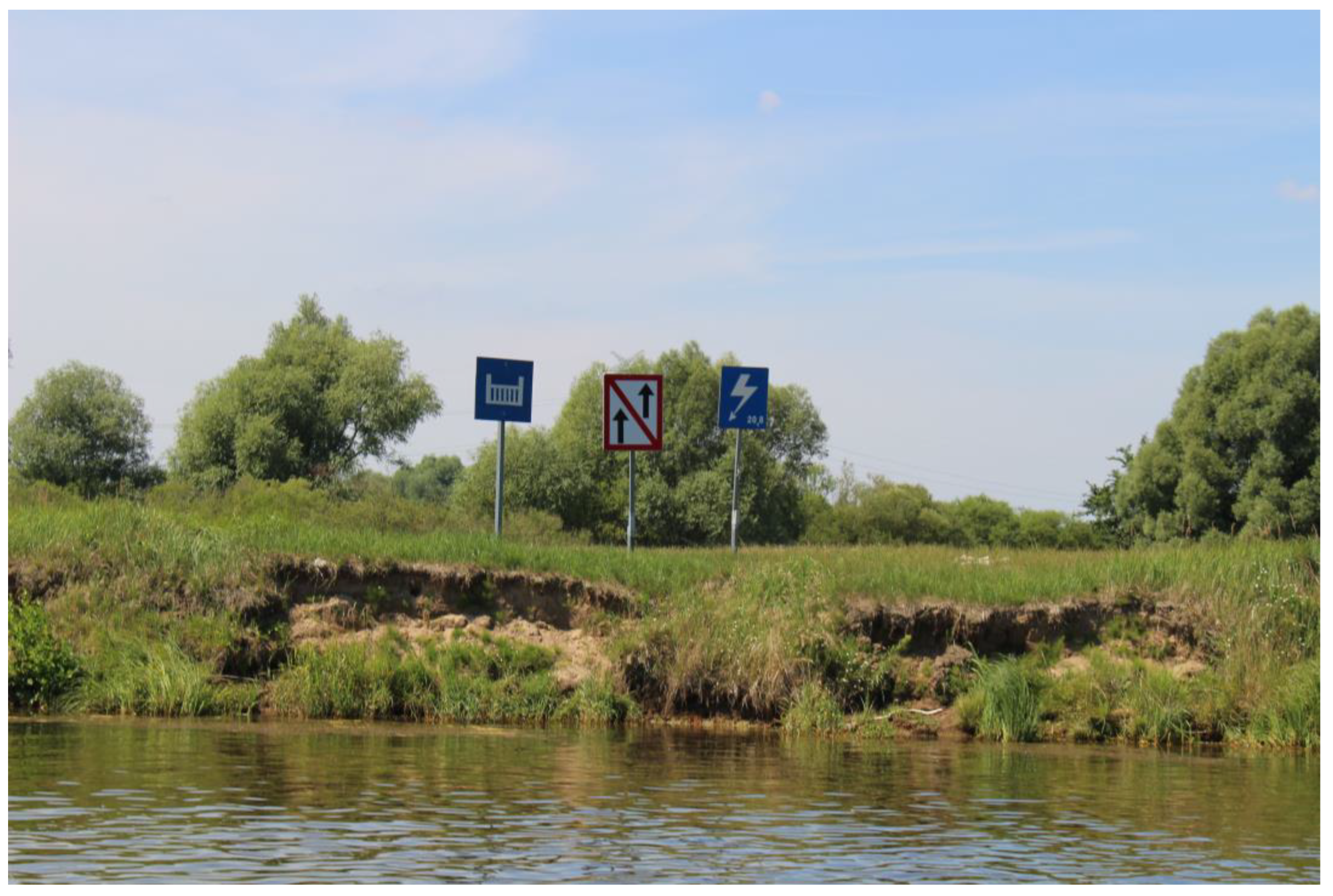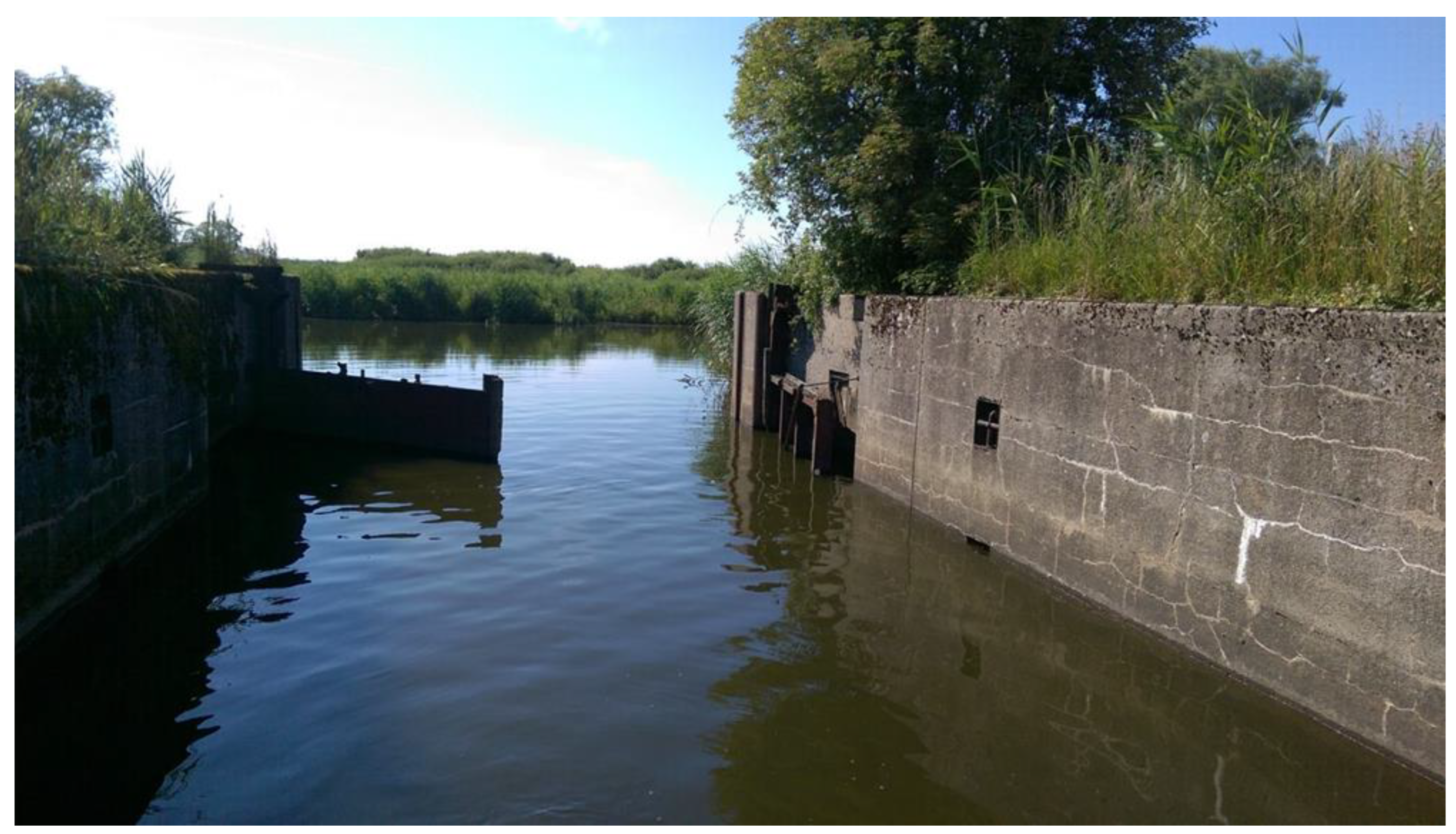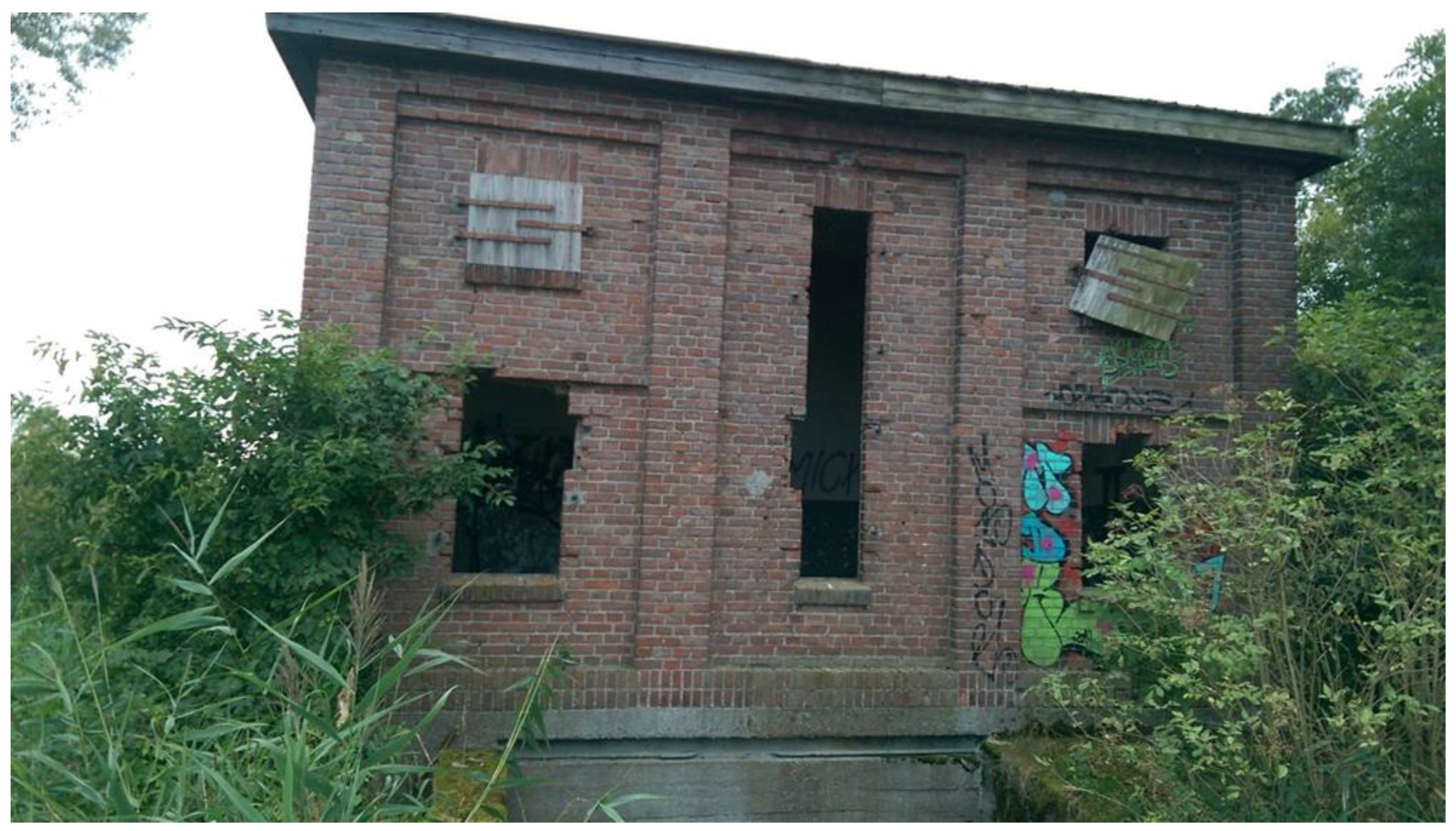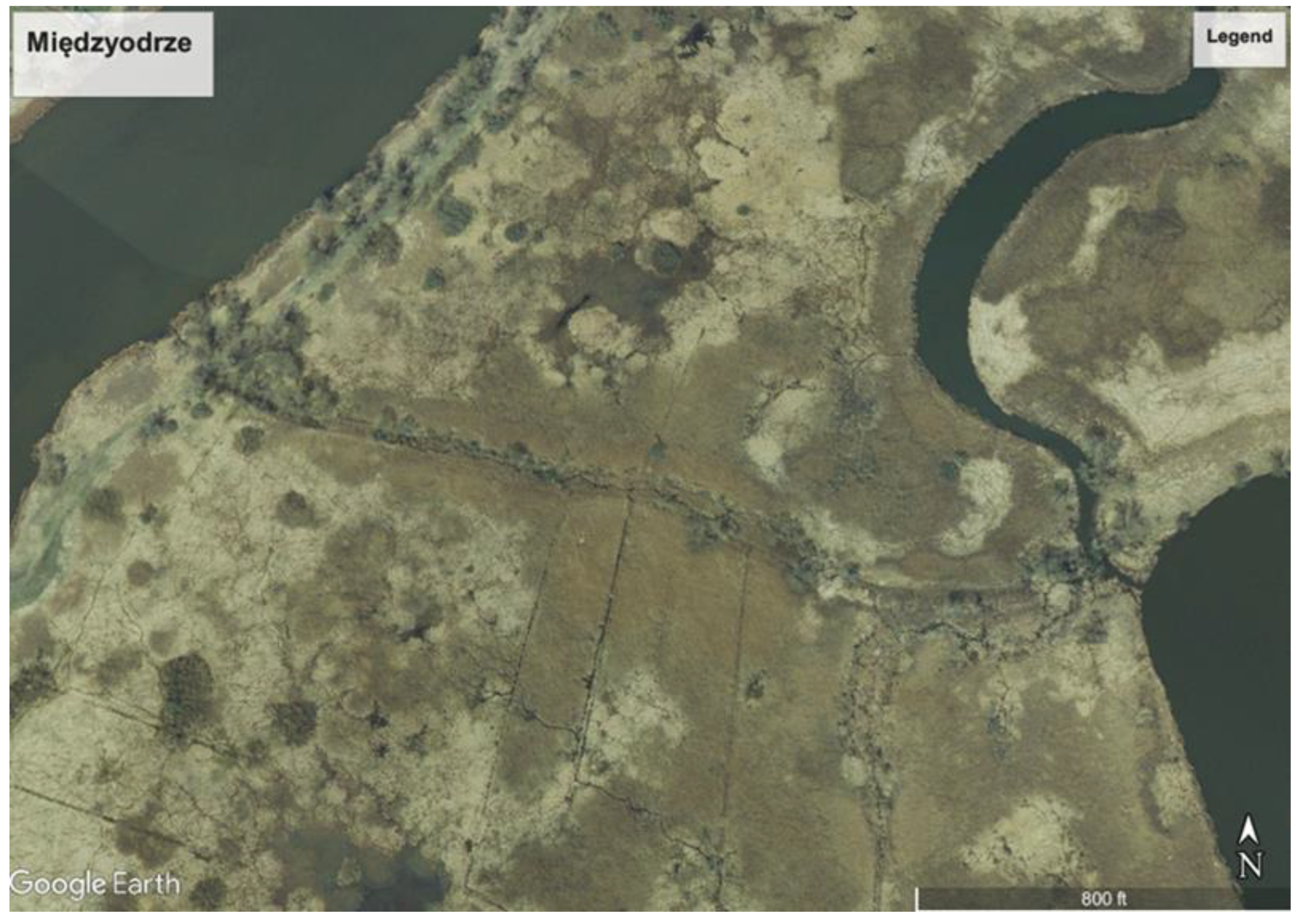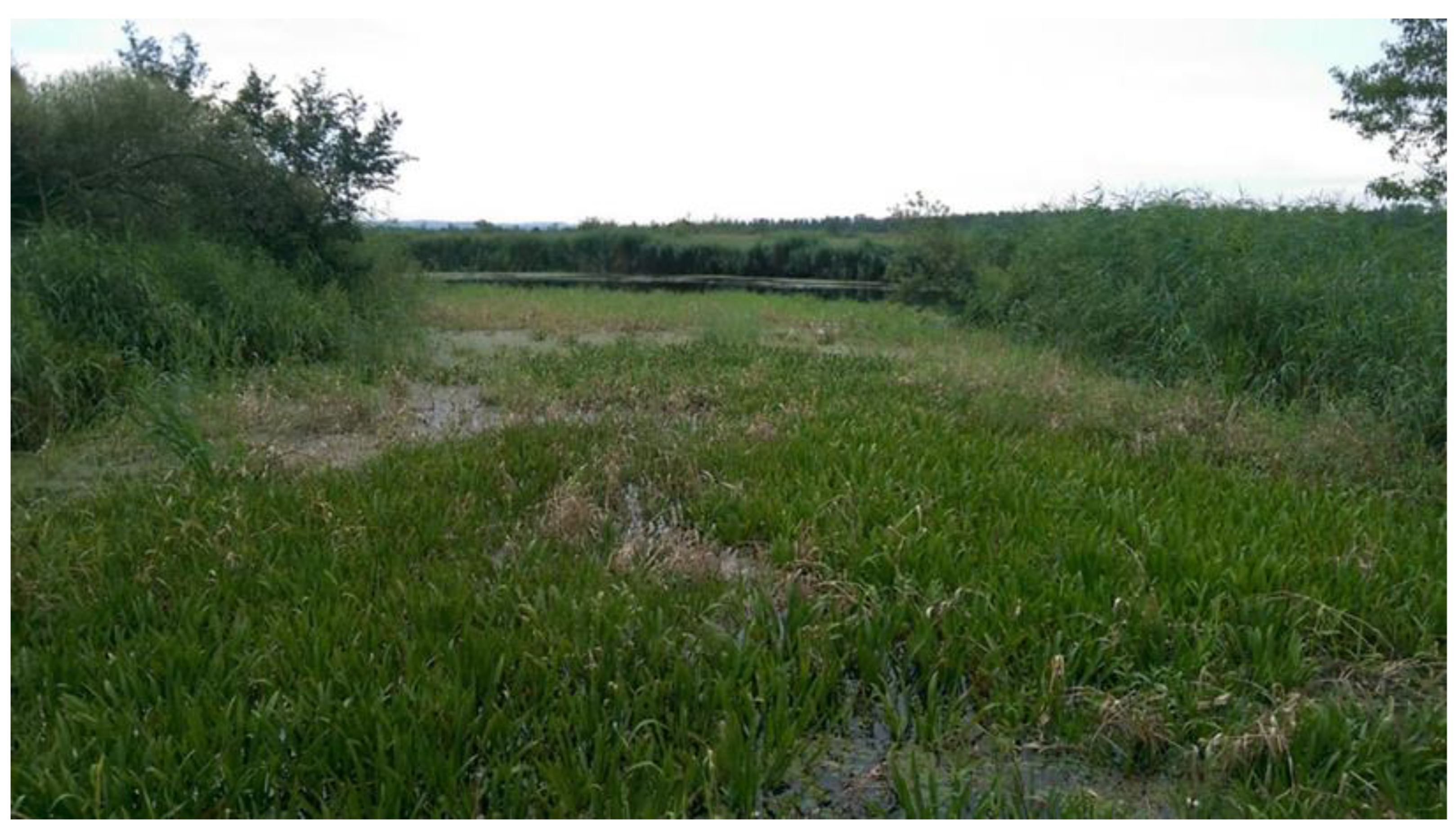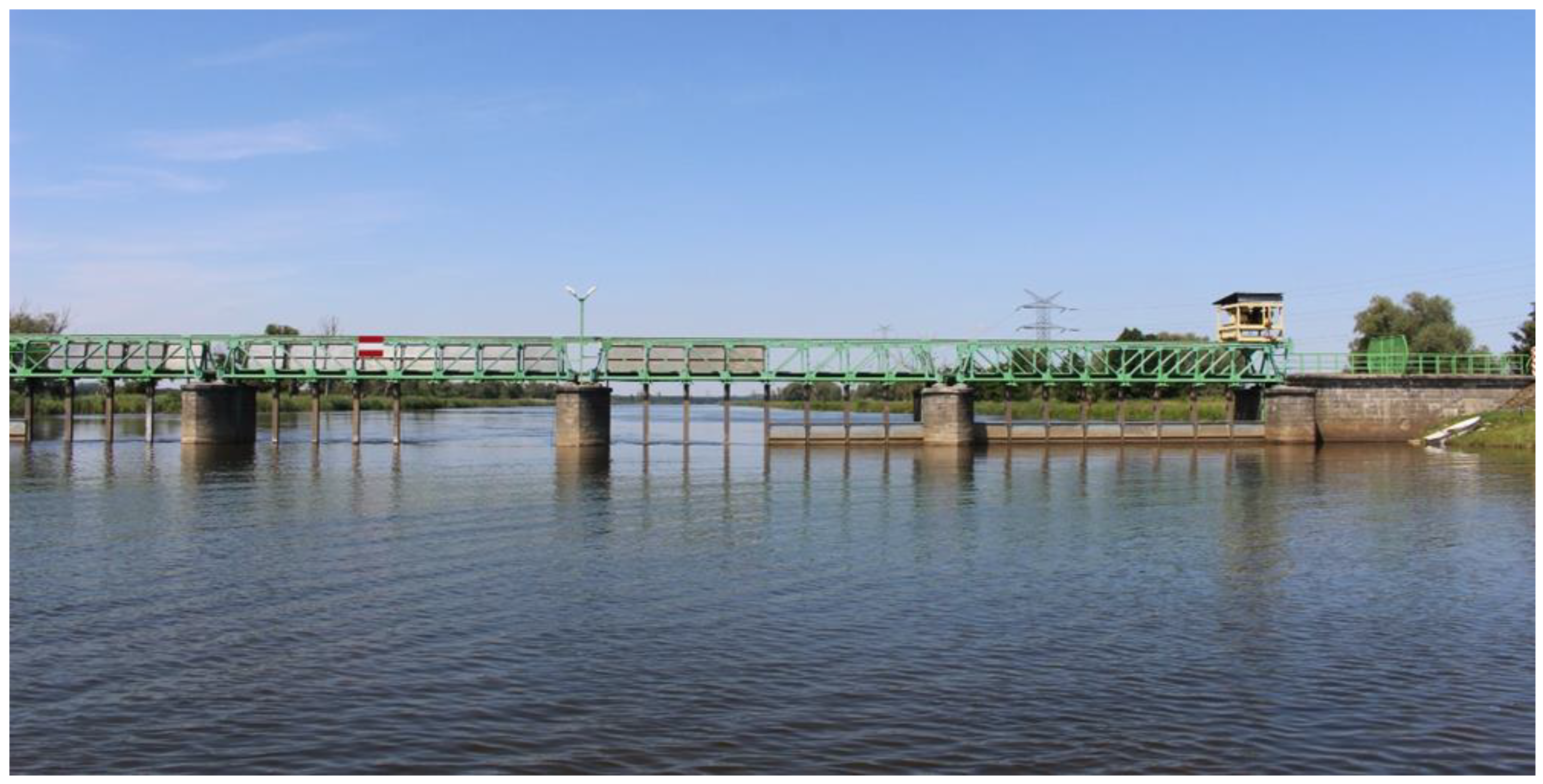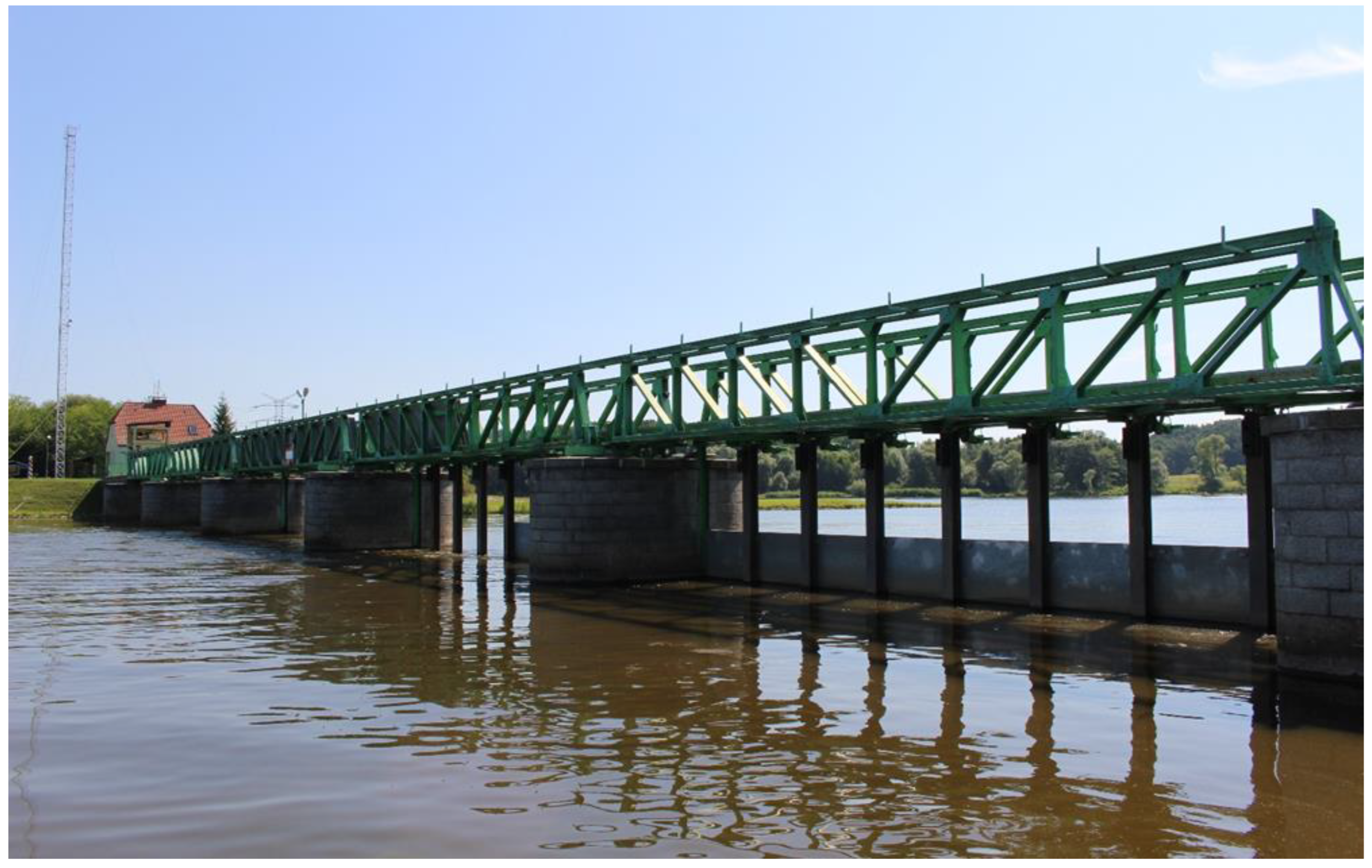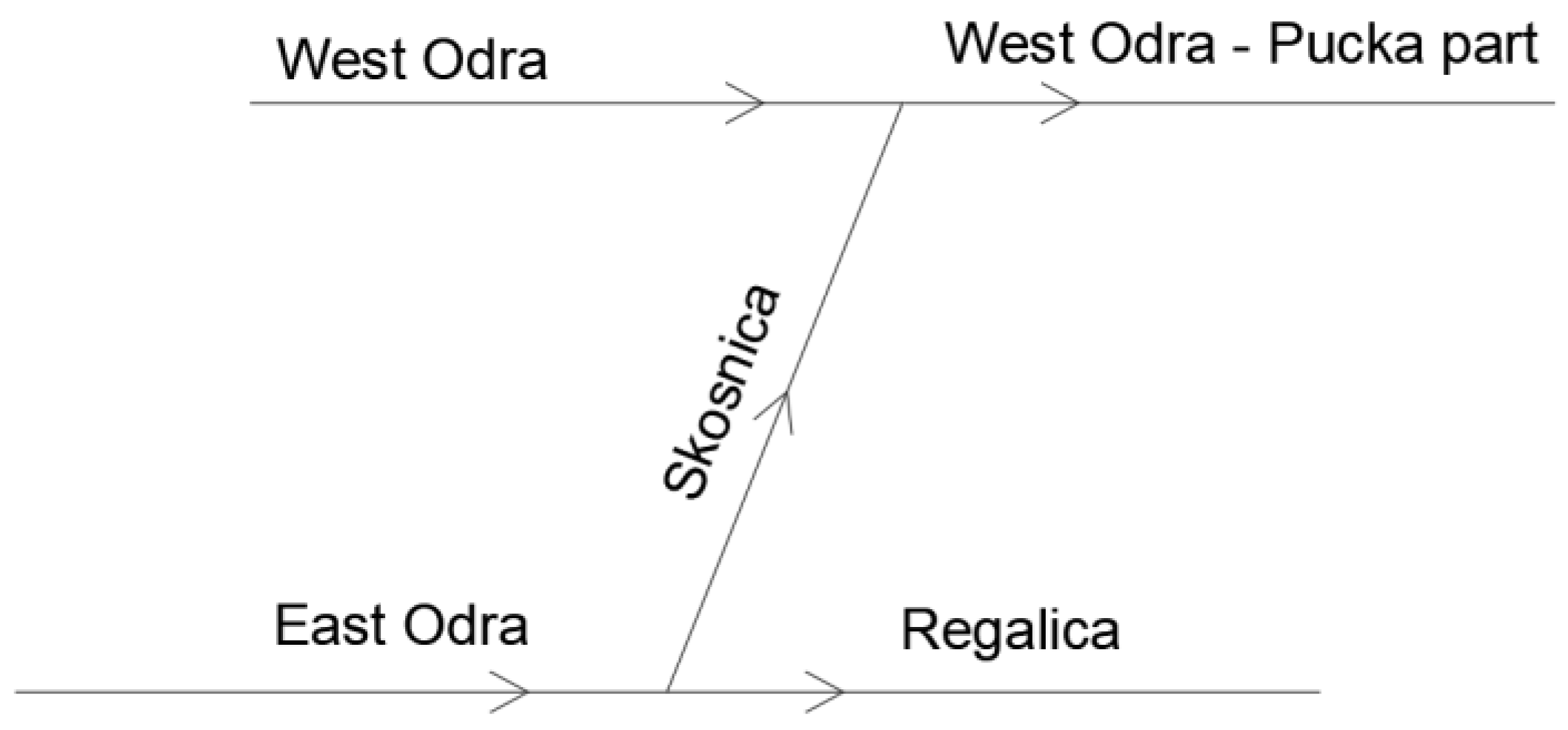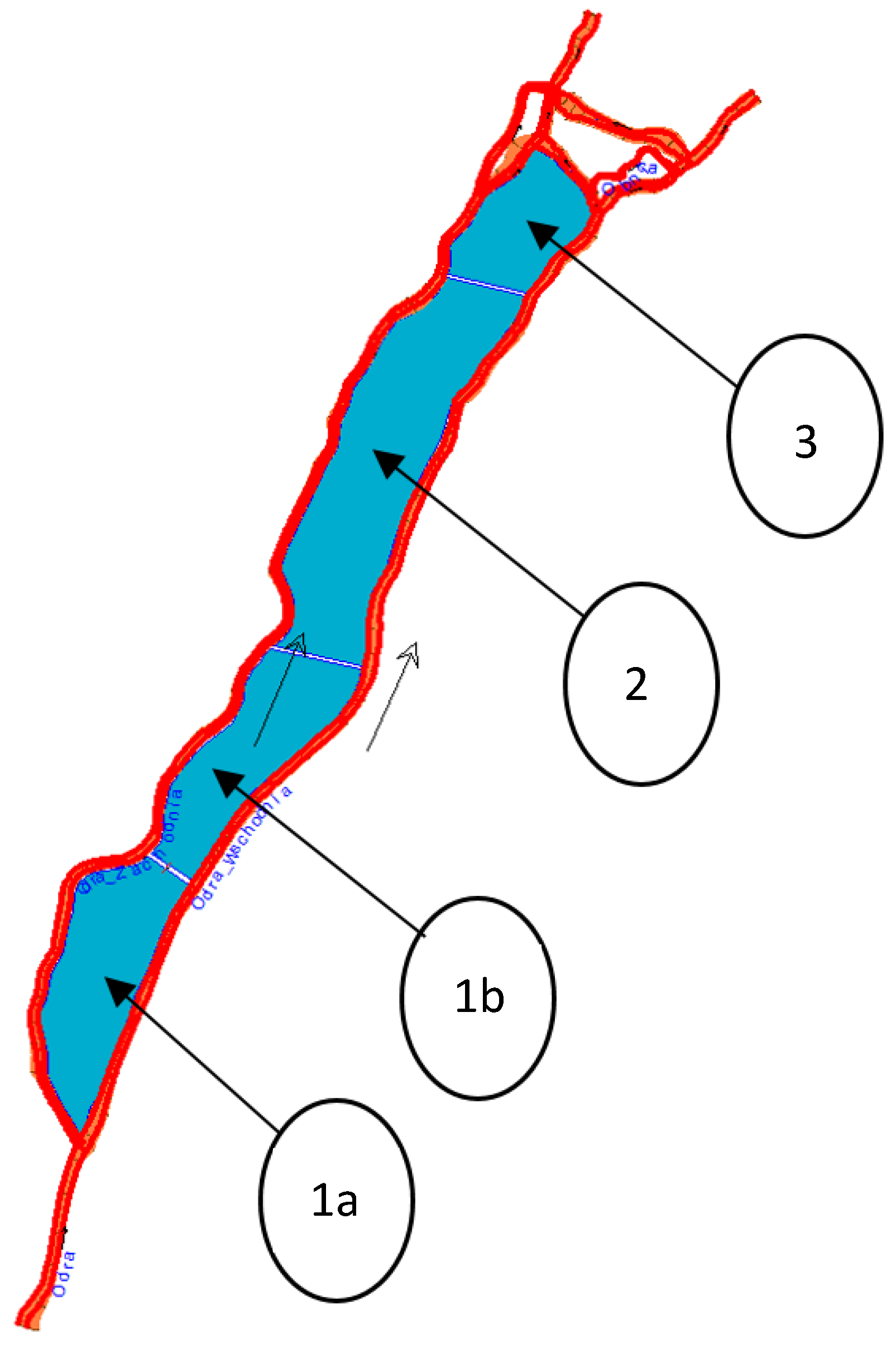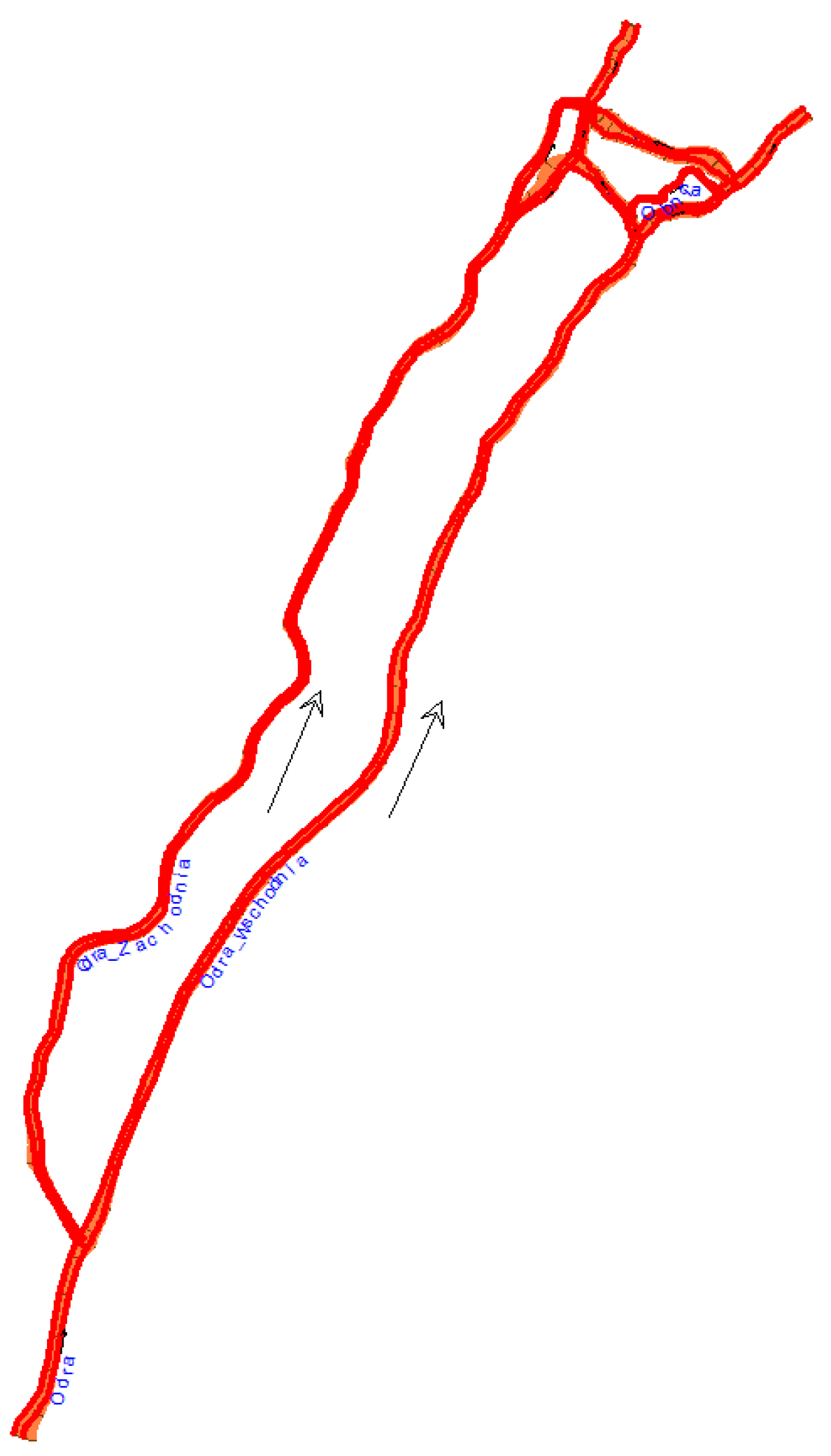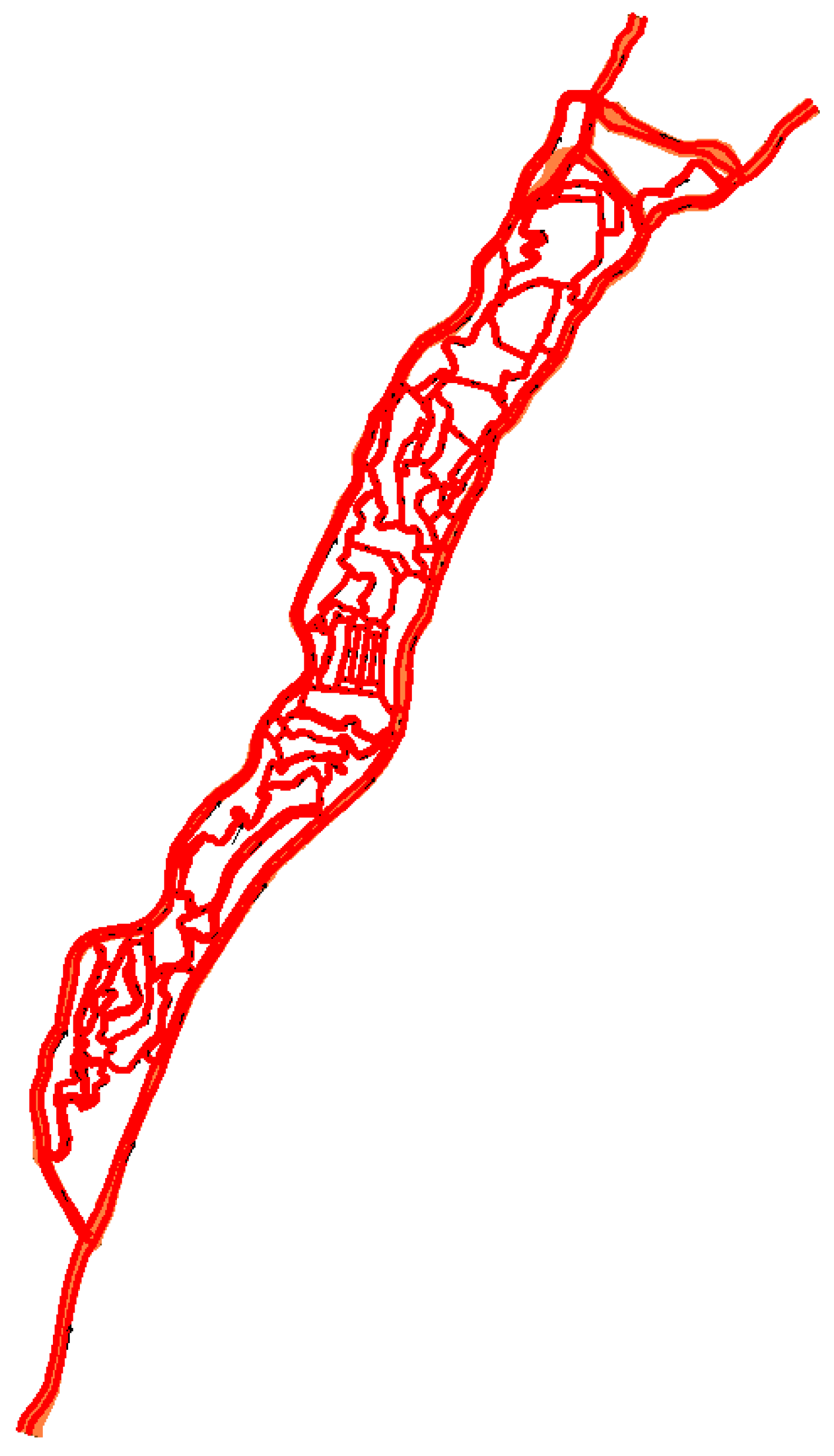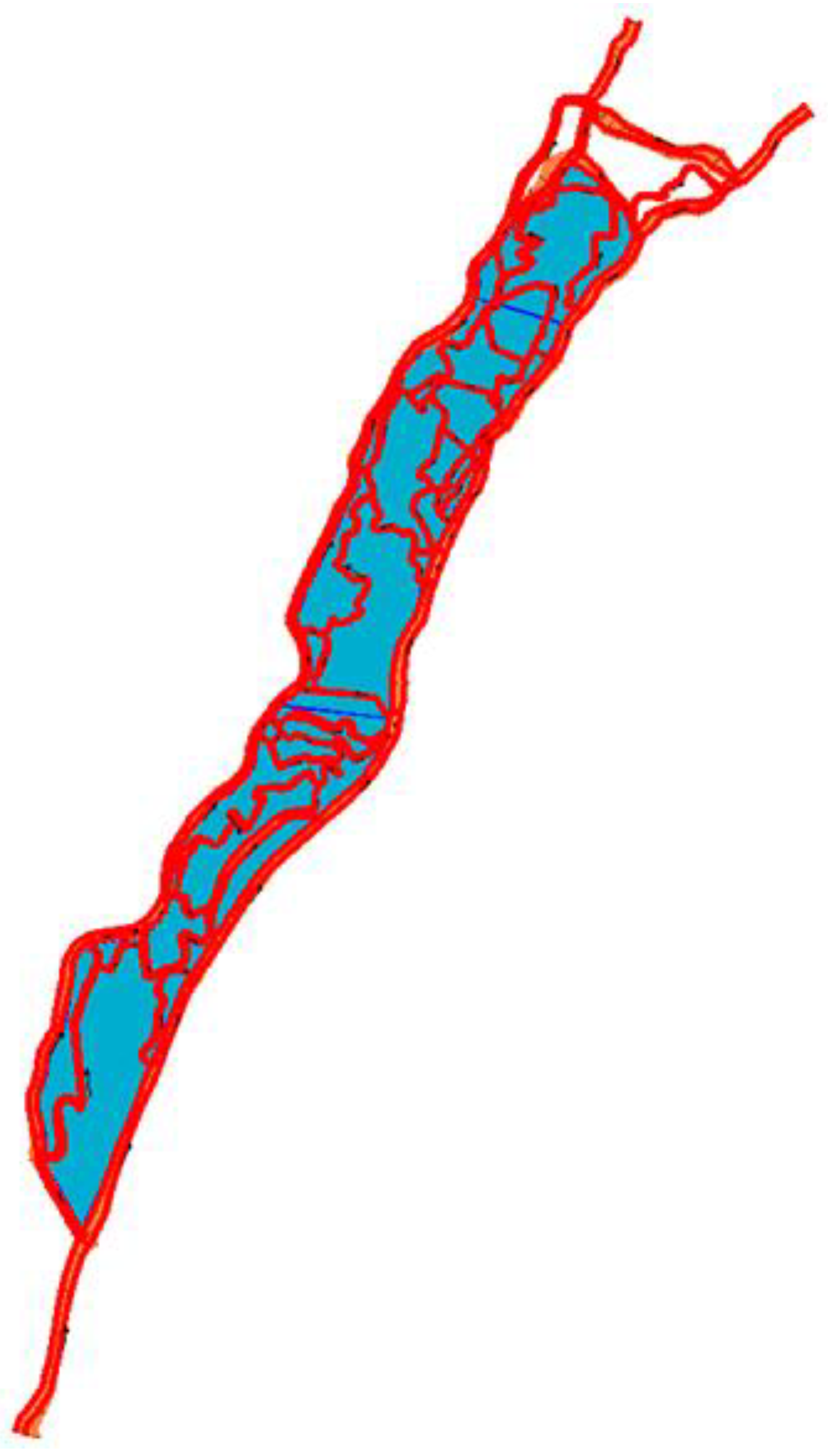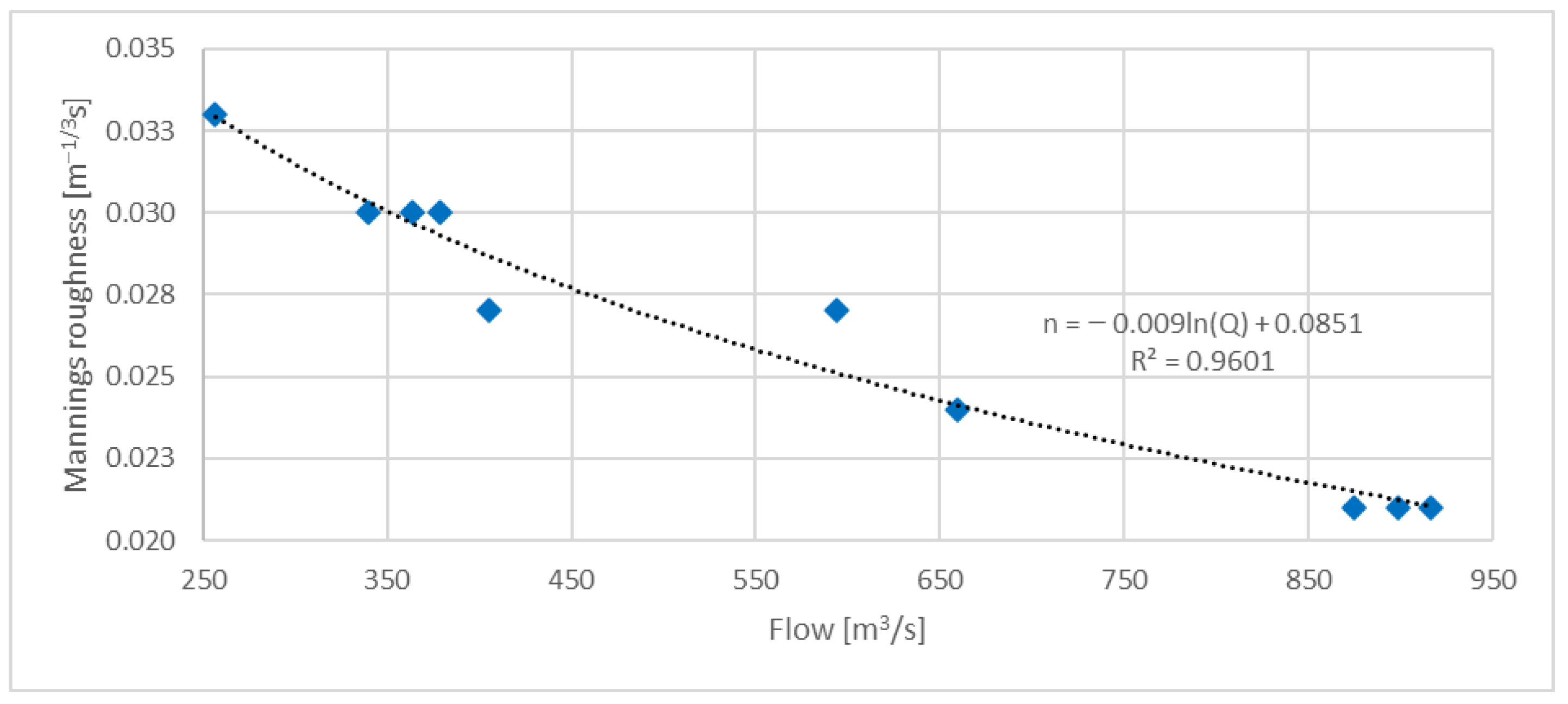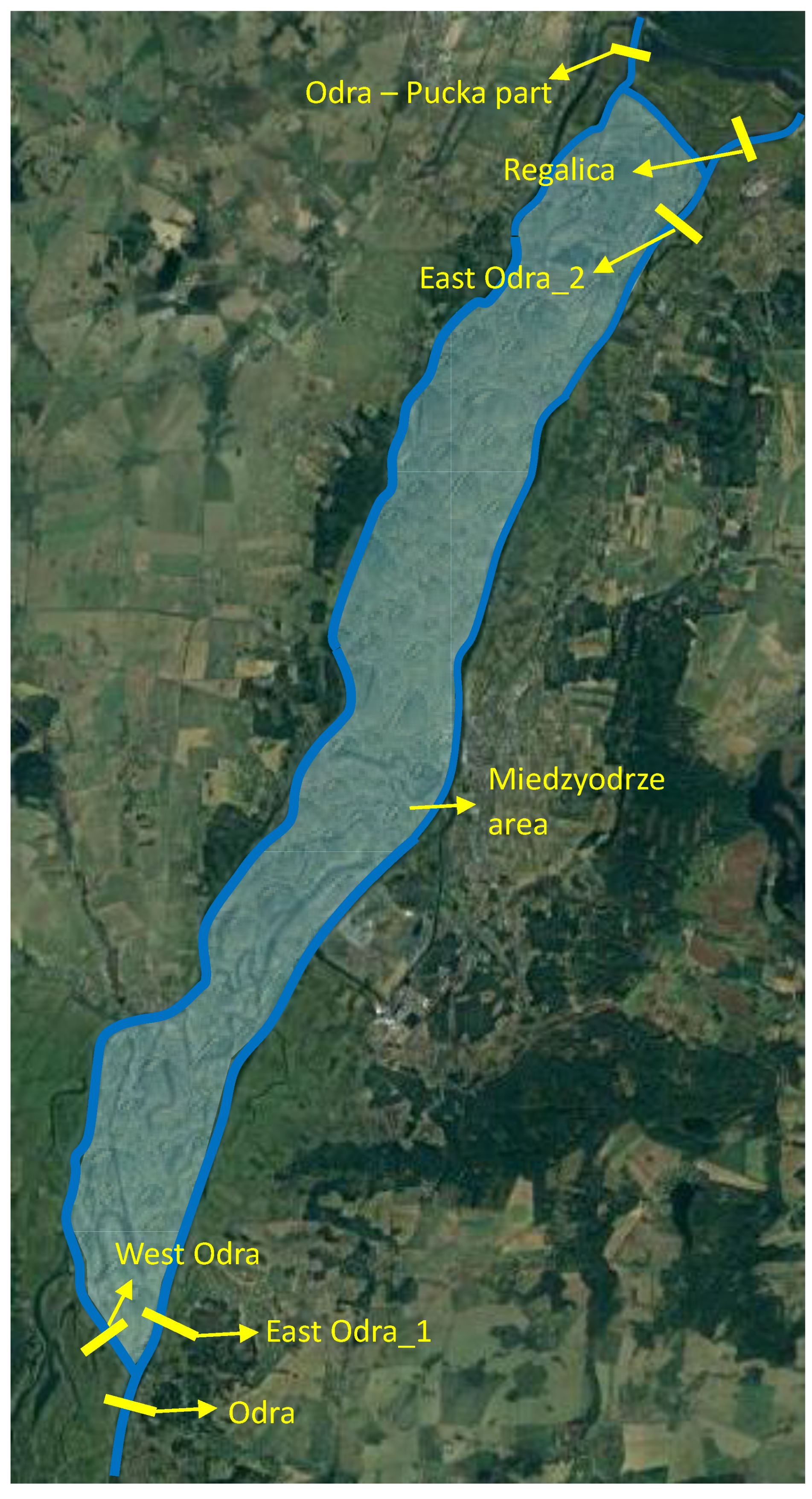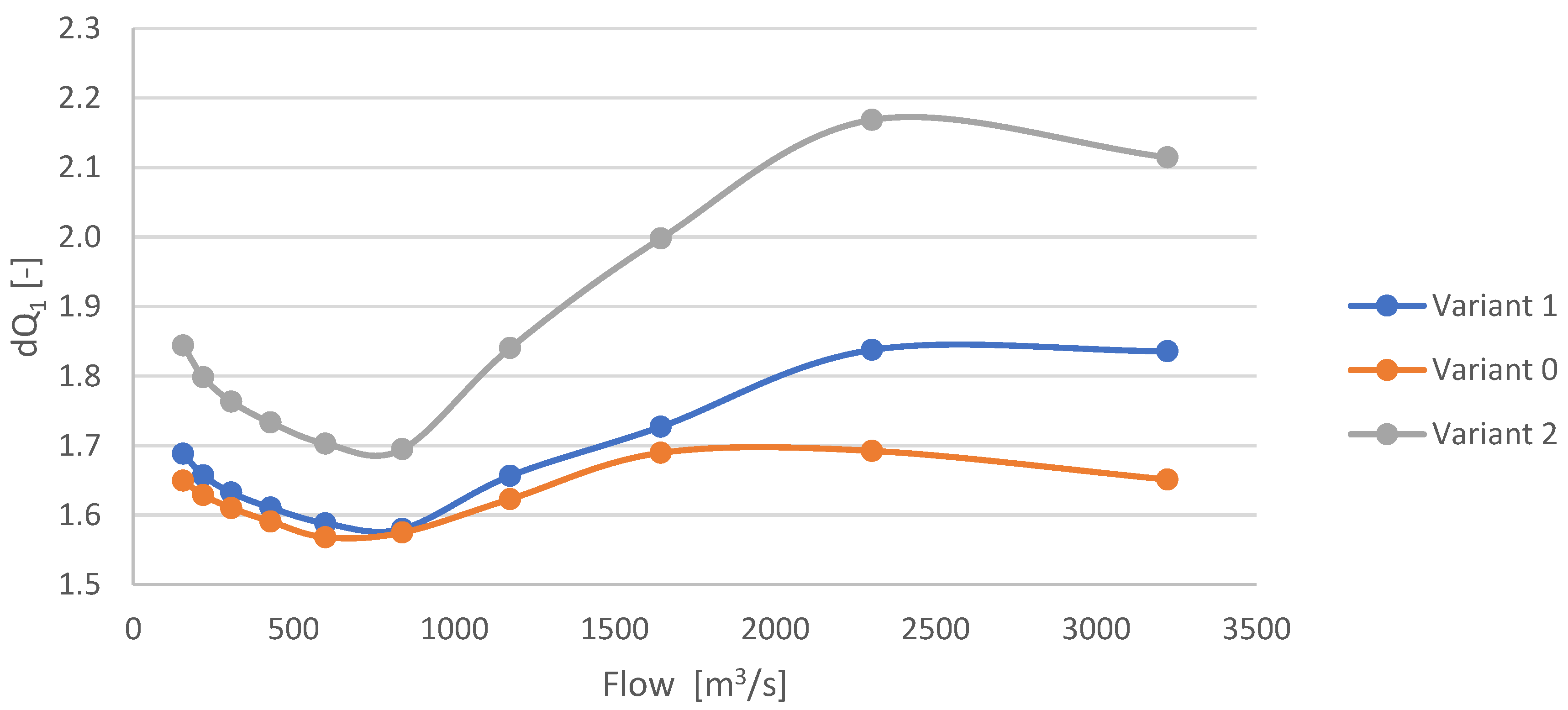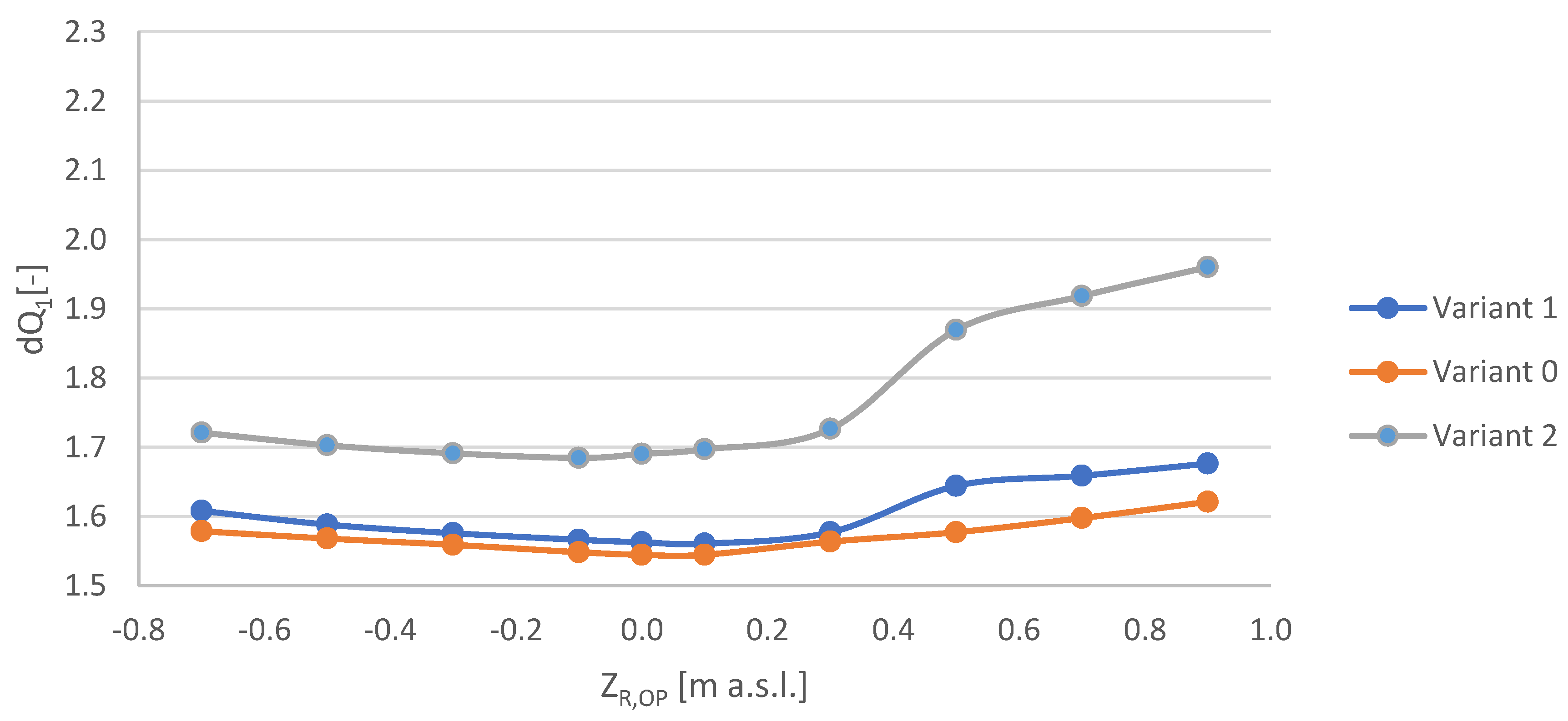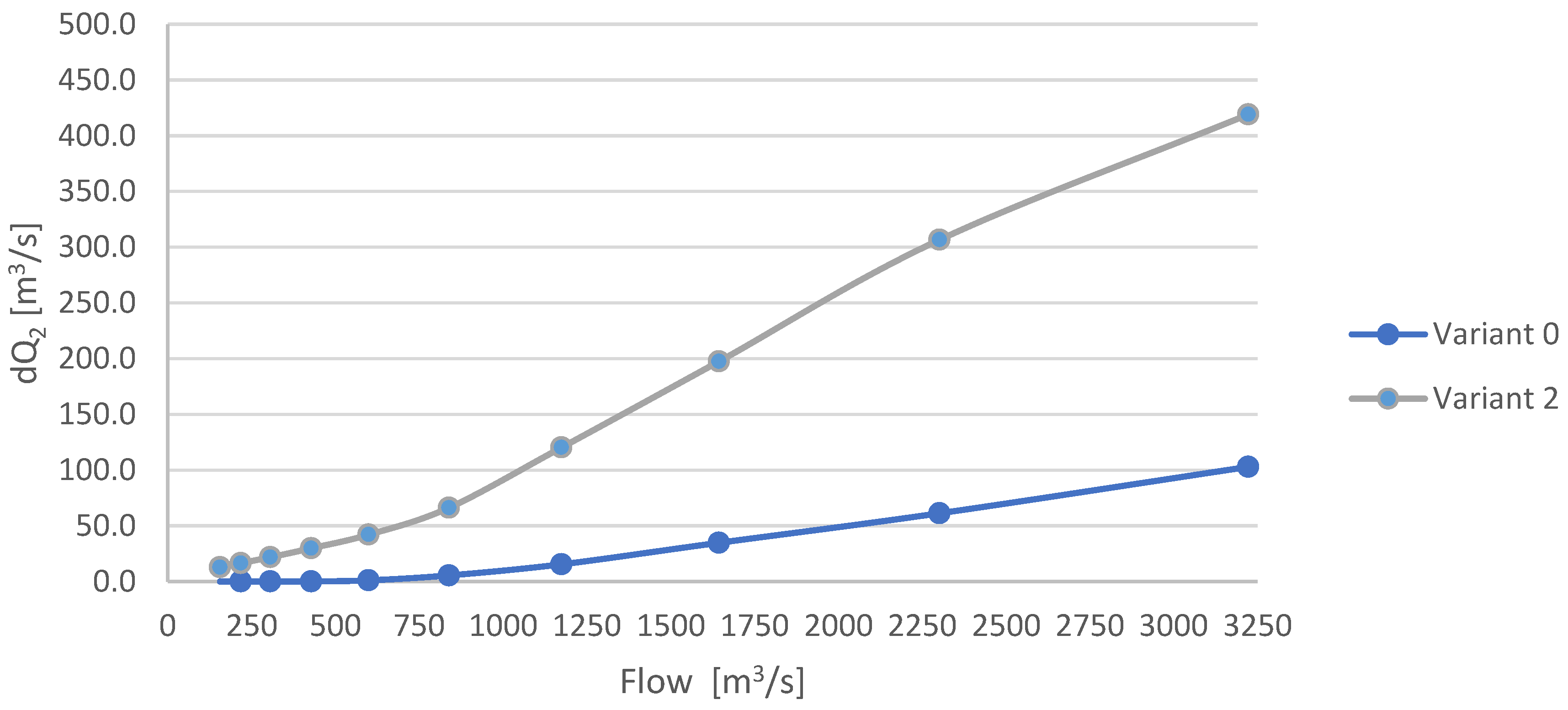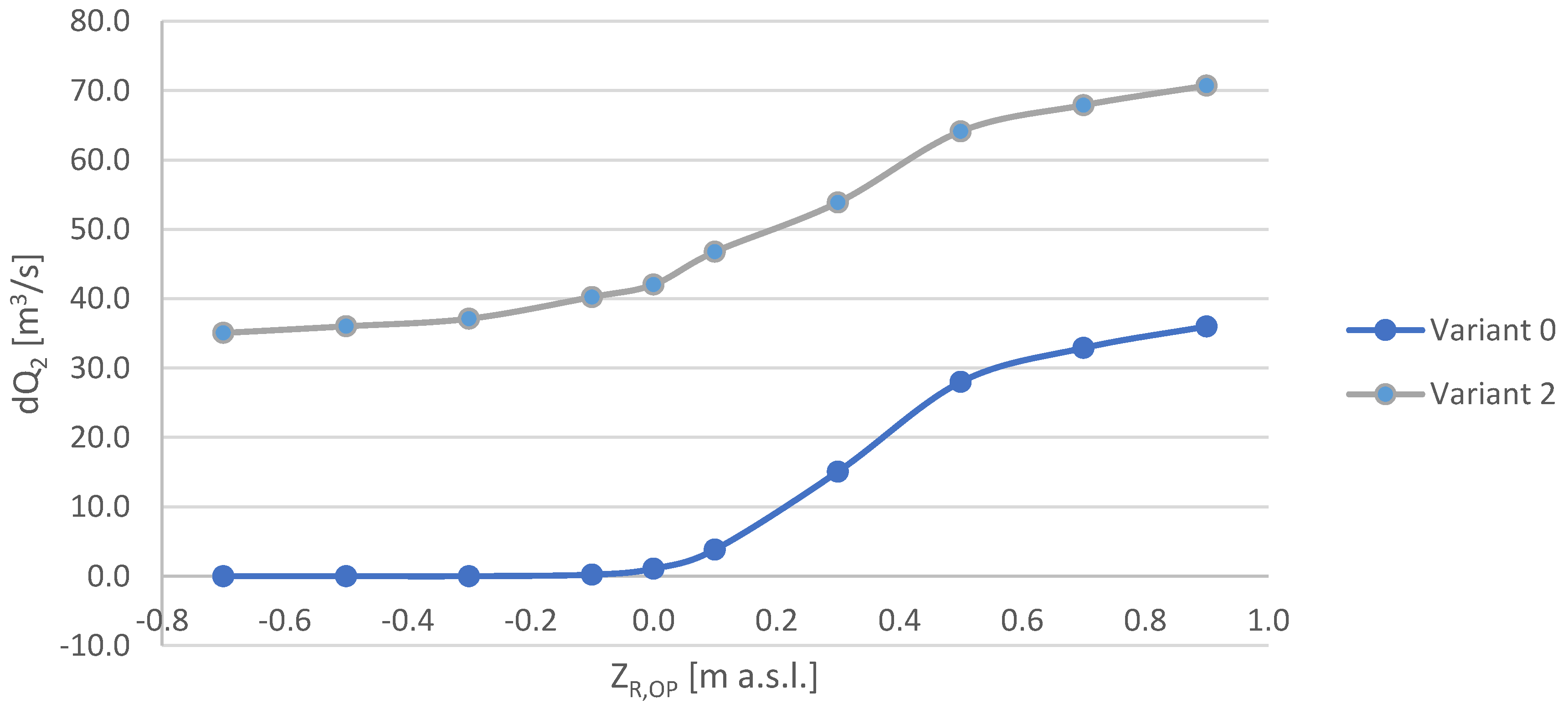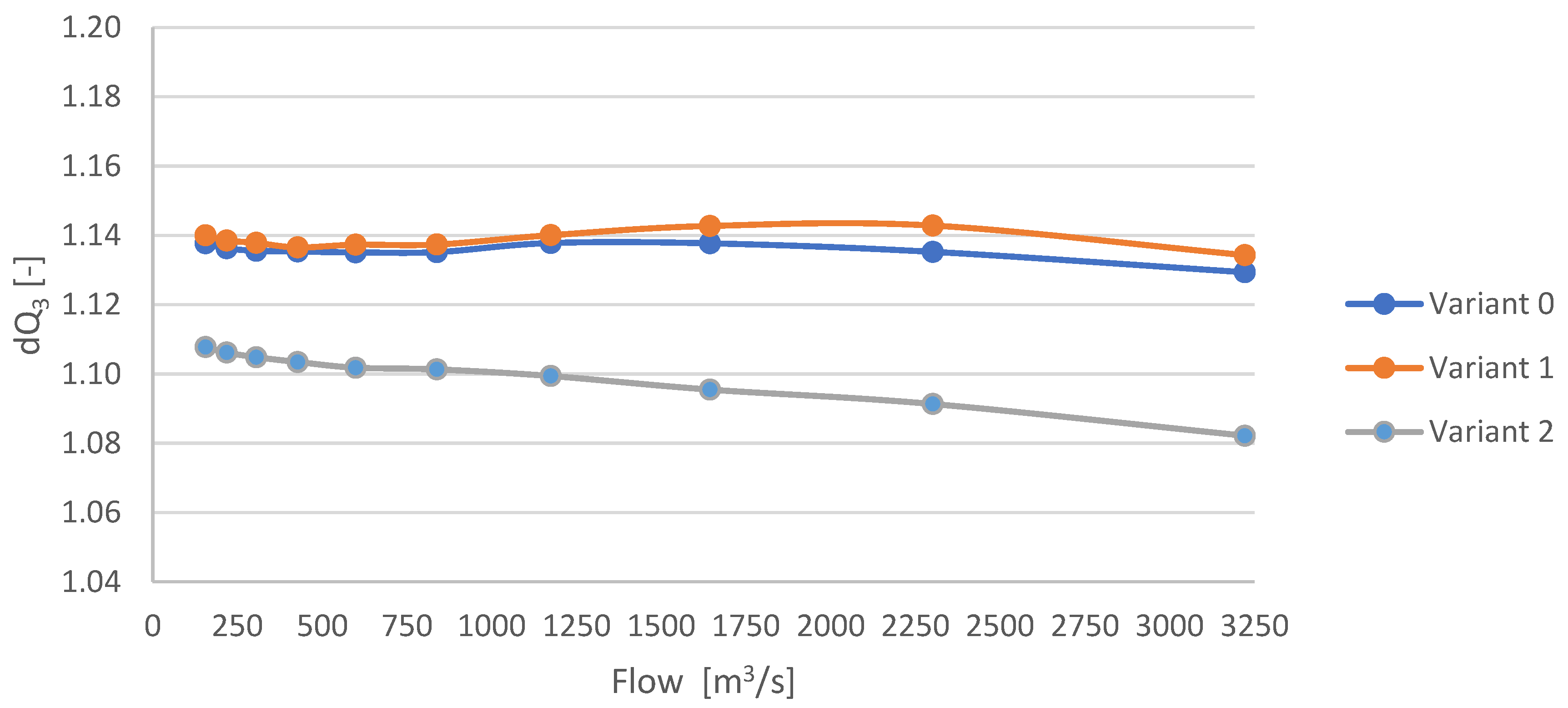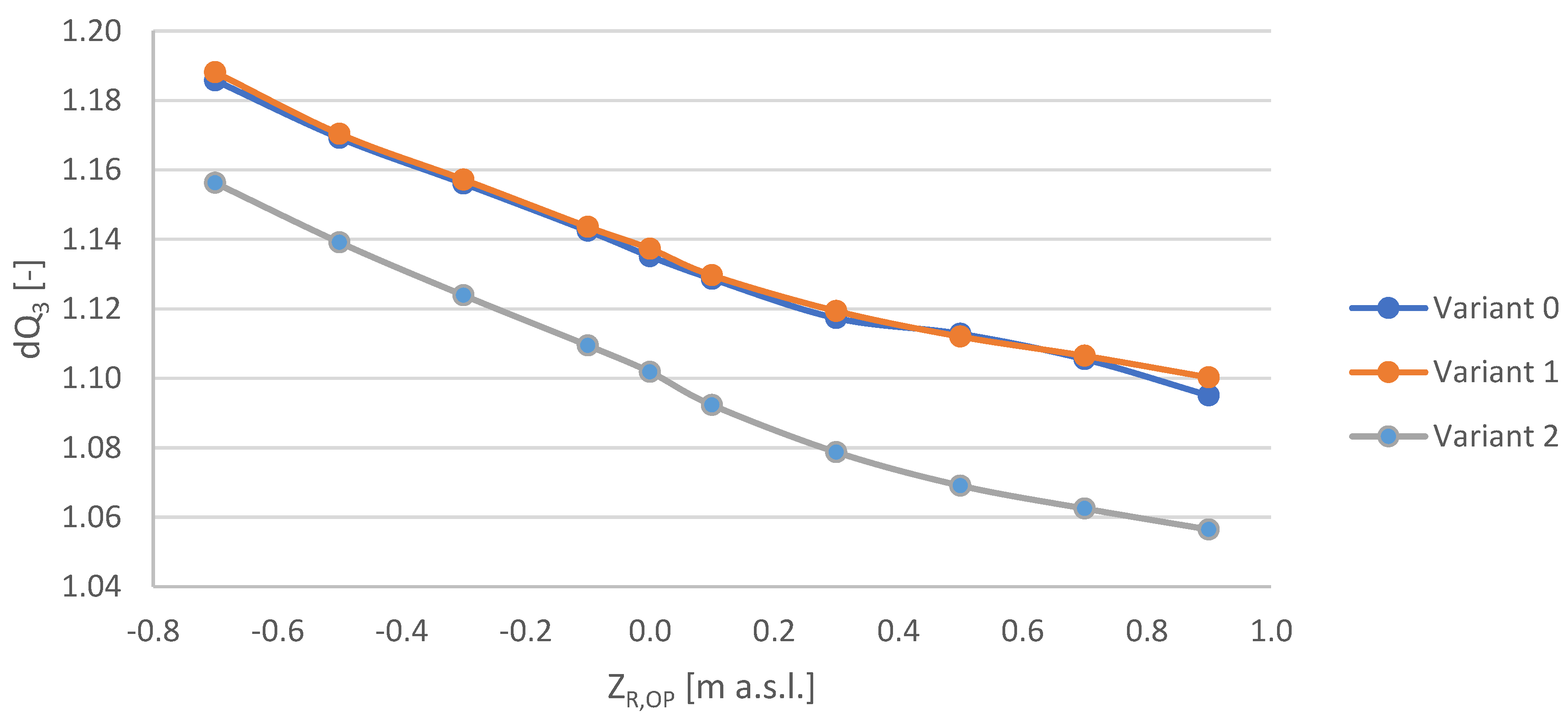1. Introduction
The issue of river floods and storm surges, as well as flood protection in river estuaries, has been a subject of interest for hydrologists for many years. The processes shaping water level profiles in river estuaries are highly complex problems that do not have unique mathematical solutions. Water level profiles in these areas are determined by multiple factors, such as flow values, the influence of the sea, and wind conditions, which do not have strict relationships. Currently, the most effective tool for describing and forecasting flow in open channels is mathematical modeling. For the model to function accurately, it requires verification and calibration based on field studies. The model will represent the hydrodynamics of water flow more accurately when more measurement data is available for the verification process, obtained under different hydrological conditions (during low and high flows and sea level profiles).
River estuaries have a significant impact on human settlements, serving as a source of water supply and wastewater discharge as well as supporting economic activities such as maritime ports and fisheries. Despite the enormous economic and social benefits associated with locating settlements in estuarine regions, it is important to acknowledge the significant flood risk associated with these areas. In the case of river estuaries, floods can occur in two ways: floods resulting from increased flow within the river channel and floods caused by storm surges during storm events. One approach to passive flood protection is the construction of flood embankments, retention reservoirs, and polder areas. These measures aim to mitigate flood risks and provide a level of flood protection to the surrounding communities and infrastructure.
A particular example is the Lower Odra area between Gozdowice and Roztoka Odrzanska. This area is highly complex from a hydrographic perspective. The dense river network with a ring-like structure, the presence of the Miedzyodrze area, and the existence of Lake Dabie make it an exceptionally interesting research subject for hydrologists [
1]. Currently, due to the devastation of hydrotechnical infrastructure, the Miedzyodrze area serves primarily as an embanked floodplain, significantly influencing the hydraulic conditions of the lower Odra River network. A characteristic feature of the lower Odra River channels is their significant depth and very small water surface gradients.
An important factor influencing the water flows in the lower Odra River network is the weir in Widuchowa, which determines the discharge values into the East and West Odra branches. Hydrotechnical structures located within the river channels require separate consideration during the construction of numerical models [
2,
3], for which a separate calibration process should also be conducted.
The first comprehensive measurements of water flow in the channels of the Lower Odra network were conducted in 2009–2010 by Kurnatowski [
1]. Despite numerous studies in the Lower Odra network, no measurements of water flow in the Miedzyodrze channels have been conducted. Research in the Miedzyodrze area from the Widuchowa node to the Skosnica channel has been limited to qualitative water quality studies, while hydraulic calculations focused on determining the distribution of flows into the East and West Odra branches and the contribution of Skosnica to the flow balance. As part of this work, field research was conducted, including point measurements of the depths of the Miedzyodrze channels, to create an up-to-date bathymetry model of this area for simulating various hydrological scenarios.
The main branches of the lower Odra River network are traversed by international waterways [
4], and therefore, carrying out revitalization works on the Miedzyodrze can significantly impact the hydrodynamic conditions along these routes.
The primary objective of this research is to undertake a comprehensive numerical analysis of hydraulic phenomena in the lower Odra River network and assess the influence of channel clearance and the renovation of hydraulic infrastructure on flow characteristics within the network. To accomplish this objective, a one-dimensional water flow model has been constructed, employing three computational variants:
Current situation—the Miedzyodrze area is treated as an uncontrolled floodplain.
Situation after the renovation of hydraulic infrastructure—all hydraulic structures are closed, preventing the involvement of the Miedzyodrze area in water flow.
Situation after channel clearance—selected channels within the Miedzyodrze area are hydraulically passable, while the areas between the channels are considered small floodplain zones.
Before achieving the stated objectives, a fundamental requirement must be met, namely the positive verification of the model based on measurement data. Due to the absence of a correlation between water levels and flows in the lower Odra River network and the consequent lack of rating curves, even a well-established measurement network can only provide reliable water level hydrographs, while the essential flow hydrographs, necessary for the process of model verification, calibration, and subsequent validation, will still be unavailable.
Due to the nature of the study, the author did not undertake a detailed analysis of the anticipated repair and modernization works. The focus of the study is the outcome, which is the restoration of the functionality of the hydraulic structures. The author limited the scope to the inventory of hydrotechnical devices in the Miedzyodrze area, emphasizing that any potential repair work should be preceded by a thorough investigation. One should take into consideration the scope of pertinent preparations. In [
5], it was indicated that the example of Indian water management policy highlights the consideration of numerous factors, primarily emphasizing the focus on conservation activities, which must form an integral part of climate change strategies. Furthermore, it has been underscored that water management systems must account for the requirements of clean water while maintaining suitable cultural and recreational objectives.
In the first half of 2022, a deepened waterway section with a depth of 12.5 m and simultaneous widening to 100 m was commissioned for use between Szczecin and Świnoujście, Poland. Currently, the maximum ship draft is approximately 9 m, which is insufficient for conducting international cargo exchanges [
6]. The deepening significantly enhances the accessibility of inland ports in the Szczecin area [
7,
8]. The contract value amounted to around 450 million USD. Due to the high value of the contract, the impact of the deepened waterway on flow hydraulics must be carefully considered. As early as 2021 [
9], concerns were raised about the potential effects of the deepened waterway on flow patterns in the lower Odra River network, leading to the potential destabilization of sediment transport dynamics. The present study serves as the initial step in further analyzing the hydraulic implications within the lower Odra River network.
2. General Characteristics of the Lower Odra River and the Miedzyodrze Area
In a typical river, three stages of its course can be observed: the upper, middle, and lower reaches. The division into these sections is based on the occurring channel-forming processes [
1]. The lower reach of the river is characterized by a smaller channel gradient, reduced bed erosion, and increased sediment accumulation. The Odra River serves as a model example of this three-part division in the Polish context. According to this division, the Odra can be classified into three distinct sections:
Upper Odra,
Middle Odra,
Lower Odra.
The Odra River originates in the Odra Mountains in the Czech Republic. The total length of the river from its source to the mouth is 854 km, with 742 km located in Poland. The catchment area of the Odra River covers nearly 120,000 km
2, of which 106,000 km
2 are located within Poland (
Figure 1).
Depending on the adopted research criteria, the concept of the “Lower Odra” can be ambiguous. Over the years, four criteria have been developed to define the area of the lower Odra:
Hydrological criterion: The Lower Odra is defined as the section of the river from Roztoka Odrzanska, near Trzebiez, to the water gauge section in Gozdowice, beyond the Baltic Sea influence [
11].
Geographic criterion: The Lower Odra begins at the mouth of the Warta River and ends at Lake Dabie.
Hydrographic criterion: The term Lower Odra refers to the section of the Odra River from the Warta River to Roztoka Odrzanska.
Navigational criterion: The Lower Odra is considered the section from Zaton Gorna (Odra-Havel Canal) to the Long Bridge in Szczecin and Lake Dabie.
Buchholz [
11,
12] and later Kowalewska-Kalkowska [
13] introduced the term “Odra River Mouth Area”, which encompasses: The river network consisting of the section of the Odra River from Gozdowice to Roztoka Odrzanska near Trzebiez, including Lake Dabie; The Szczecin Lagoon; and the maritime straits through which the Odra River flows into the Baltic Sea: Dziwna, Swina, and Piana.
According to [
14,
15], the Odra River Mouth Area can be classified into three types of estuaries based on the upper and lower boundaries:
First-order estuary: Pomeranian Bay,
Second-order estuary: Greifswald Bay and Szczecin Lagoon, including Achterwasser Bay and Lake Wrzosowskie,
Third-order estuary: Lake Dabie, which is connected to the Szczecin Lagoon via Inski Nurt, West Odra, and Roztoka Odrzanska.
From Gozdowice (at km 645.3) to Widuchowa (at km 701.8), the Odra River flows in a wide curve with an initial northwest deviation of about 17 km, then northward for approximately 14 km, and finally turns northeast for about 27 km. The entire stretch of the Odra River in this section forms the border between the Republic of Poland and the Federal Republic of Germany. The average depths on this stretch range from 2.5 to 3.0 m, and the average water surface width is around 140–150 m [
9,
13]. Between the Widuchowa and Gozdowice water gauge cross-sections, the Slubia River (at km 652.5), Cedynski Canal (at km 673.4), and Rurzyca River (at km 695.2) are tributaries [
16]. At km 704.1, the Odra River branches into the East Odra, which is the main navigation channel, and the West Odra, separated by a weir called the Widuchowa weir. After the bifurcation, both branches of the Odra generally run parallel to each other and are oriented northeast. The West Odra, from Widuchowa to Roztoka Odrzanska, has varying depths ranging from 6 to 10 m and water surface widths between 140 and 200 m. The East Odra flows into the large flow-through Lake Dabie and has average depths of around 7 m and water surface widths ranging from 150 to 160 m throughout its length. The area between the West and East Odra is called Miedzyodrze and was used for agricultural purposes before World War II. In the northern part of Miedzyodrze, at km 730.5, the East Odra connects to the West Odra (29.8 km of its course) through the Skosnica channel, which is approximately 2.5 km long. The average depth of Skosnica is about 3.5–4 m, and the water surface width is around 110 m [
11,
12]. Other important connections between the East and West Odra include the Odynca, Gryfino, Mielenski, and Parnica channels. From this point, the East Odra is referred to as Regalica, and from Parnica to its mouth, it is known as the Mienia River. The Marwice-Gartz Canal is a significant connection between the Odra branches. It is the only canal crossing Miedzyodrze that allows vessels with outboard combustion engines to navigate. A comprehensive depiction of the lower Odra valley’s attributes can be examined within reference [
16]. Due to the typical nature of a river estuary, the lower Odra is less susceptible to alterations in its morphology compared to its middle and upper reaches [
17]. One characteristic feature of the Odra River Mouth is its kilometrage, which has been divided into three ways due to various factors such as navigation, the Widuchowa weir, and the administrative division between maritime inland waters and inland waters [
18]:
According to the Institute of Meteorology and Water Management, the Odra River stretches from Gozdowice (645.3 km) through the East Odra and then Skosnica (starting at 730.5 km and ending at 733.2 km), and further via the West Odra to the Inski stream (753.1 km of the Odra River).
According to the Maritime Office in Szczecin, the waterway extends from the central breakwater (formerly known as the east breakwater) in Swinoujscie to the Long Bridge in Szczecin, known as the Swinoujscie-Szczecin waterway (66.5 km).
According to the Maritime Institute in Szczecin, the West Odra is a separate kilometer from the Widuchowa weir to the Long Bridge (36.6 km).
Due to various kilometrage systems, distances between cross-sections or even individual objects calculated along the river axis may often only be approximated [
1], resulting in divergent values presented in the scientific literature.
Lake Dabie, where the East Odra flows, has an area of 56 km
2. The maximum length of Lake Dabie is approximately 15 km, the maximum width is about 7 km, and the maximum depth is around 4.2 m [
6,
7]. Lake Dabie is a relatively shallow body of water. Between 1962 and 1996, the average depth of Lake Dabie decreased from 2.84 to 2.61 [
19], indicating a reduction in the lake’s volume of approximately 13 million cubic meters [
20].
In
Figure 2 [
1], the area of the lower Odra network (from the Widuchowa junction to Roztoka Odrzanska) is presented.
The area bounded by the East Odra and West Odra, from the Widuchowa junction to the Inski stream, is called Miedzyodrze [
21]. In the southern part of the Miedzyodrze area (from the Widuchowa junction to the Odyniec Canal), the Lower Odra Valley Landscape Park is located, designated as an area of exceptional natural and cultural value since 1 April 1993. The Park is a unique collection of peat bogs and wetlands on a European scale [
1].
As a consequence of World War II, numerous hydro-technical structures in the Miedzyodrze area were damaged. It was not until the 1960s that these structures were reconstructed and put back into operation, allowing for the renewed agricultural utilization of the Miedzyodrze region. However, due to the escalating operational costs of the hydro-technical facilities, agriculture became financially unviable. The lack of maintenance and oversight of the hydraulic devices led to the re-destruction of the majority of these structures. Subsequently, near-complete naturalization and ecological succession took place.
Due to the prevailing marshiness of most of the Miedzyodrze area, the region has become poorly accessible and, in certain locations, entirely inaccessible to humans. The numerous instances of canal and hydro-technical equipment devastation have rendered them currently devoid of any regulatory functions within Miedzyodrze. Despite the distinctive natural values presented by Miedzyodrze in comparison to Europe (and possibly the world), it is essential to bear in mind and frequently emphasize that the current state is attributable to human influence, specifically the political circumstances of the 1950s and 1960s, which facilitated the degradation and naturalization of this area.
One characteristic feature of the Miedzyodrze area, from the Widuchowa Junction to the Skosnica channel, is the presence of polders. These are flat areas designated for inundation during the autumn-winter period, slightly elevated above the average water level in the river. The elevations of the polders range from approximately 0.00 to 0.40 m above sea level. Following the network arrangement, Miedzyodrze has been artificially divided hydrographically into three independent polders:
Widuchowa Polder, also known as the southern polder, encompasses the area from the Widuchowa Junction to the embankment of the Gryfino-Mescherin road.
Gryfino Polder, known as the middle polder, covers the area from the embankment of the Gryfino-Mescherin road to the embankment of the A6 Motorway.
Szczecin Polder, referred to as the northern polder, extends from the embankment of the motorway to the Skosnica.
The Miedzyodrze area also includes the region between Skosnica and the Odynca Canal, which is also known as the Regatta Track. [
11]
Detailed information about the Miedzyodrze polders, including their surface area, watercourse area, and average elevations, is presented in
Table 1 [
18].
Hydrotechnical structures in the Miedzyodrze area
During the construction works aimed at proper water management, 35 hydrotechnical structures were built, including:
18 chamber-economic locks,
2 chamber-navigation locks,
6 weirs (embankment overflow structures),
5 embankment culverts,
4 pumping stations.
Chamber-economic locks:
The purpose of the chamber-economic locks was economic transportation, mainly for transporting hay from the Miedzyodrze area. The majority of these locks, specifically 10 of them, were located in the southern polder. Each of the middle and northern polders had four locks.
Chamber-navigation locks:
The main function of the chamber-navigation locks was to provide a navigable connection between the East Odra and the West Odra. Both locks facilitated the passage of barges with a displacement of up to 400 tons.
The locks are single-chamber locks without a drop gate. They were entirely made of concrete, with reinforced concrete main walls and concrete retaining walls. The upper parts of the chamber navigation locks were faced with clinker bricks. Each lock was equipped with double-leaf supporting gates operated manually from the shore using lifting rods and gear mechanisms. The gates had closing orifices controlled by valves, which allowed for changing the water level in the chambers during the passage of floating vessels [
11,
12,
14]. Both locks are located on the Marwice-Gartz channel, which is the only channel in the Miedzyodrze area that allows the movement of motor-powered vessels.
Embankment overflow structures:
Six embankment weirs let floodwaters into the Miedzyodrze area during the summer period and inundated the polders during the autumn-winter season. These weirs are concrete structures with one or two spans equipped with flat gates (2 embankments) or sliding flaps (4 embankments). The closures were manually operated through a system of gear transmissions, lifting rods, and coupling devices [
22]. Three weirs are located in the southern polder, two in the middle polder, and only one in the northern polder.
Embankment culverts:
The purpose of the embankment culverts was to assist in water level regulation in the Miedzyodrze area. The self-closing supporting gates installed in the culverts protected the Miedzyodrze area from excessive water inflow during high water levels in the East Odra. During low water levels, the culverts discharged excess water from the Miedzyodrze area, thus supporting the pumping stations. The embankment culverts are concrete structures with one or multiple rectangular-shaped channels. The southern polder has four embankment culverts, while the middle polder has one.
Stations pumping
The main purpose of the pumping stations was to maintain the optimal water table level in the Miedzyodrze area, ensuring optimal water conditions for the green areas located there. There are two pumping stations in the southern polder and one each in the middle and northern polders.
Flood embankments
The Miedzyodrze area is protected by embankments from the east, west, and northern sides. The flood embankments, with an average height of 1.5 m, protected the Miedzyodrze polders up to an Odra flow rate of 1600 m
3/s (according to the Hohensaaten water gauge) [
22]. Buchholz [
11], based on archival materials, determined the lengths of the flood embankments in the respective polders, which are presented in
Table 2.
Similar to the hydrotechnical structures in the Miedzyodrze area, the flood embankments have undergone extensive deterioration due to a prolonged lack of maintenance. The embankment slopes have experienced significant slippage, resulting in localized reductions in the height of the flood embankments. Animals, particularly beavers, have had a significant impact on the degradation of these embankments. An example of embankment slippage at the beginning of the East Odra is depicted in
Figure 3.
Figure 4 and
Figure 5 depict selected deteriorated hydrotechnical structures in the Miedzyodrze area.
The exact causes behind the devastation of water infrastructure remain partially elusive. The destruction of locks can be attributed to a multitude of factors. Primarily, the aging of infrastructure emerges as a significant cause, particularly in the case of older locks that have endured inadequate maintenance or upgrading over prolonged periods. Moreover, deliberate acts of sabotage, acts of vandalism, or unforeseen technical malfunctions can precipitate damage to locks.
Miedzyodrze’s channels
The absence of regular maintenance practices and unimpeded sedimentation and debris accumulation have been key factors contributing to the shallowing of the Miedzyodrze channels, ultimately leading to the cessation of unimpeded surface water flow within the area. The exchange of water within the channels now predominantly occurs during significant flood events, effectively submerging the entire Miedzyodrze area. The lack of continuous water exchange within the channels has resulted in the complete colonization of certain channel segments by vegetation (see
Figure 6 and
Figure 7).
Due to the current condition of the channels, aerial photographs are insufficient for identifying all the channels in Miedzyodrze. Therefore, on-site inspections were necessary to accurately assess the actual state of the channels. It is estimated that there are over 200 km of channels in the Miedzyodrze area, which significantly extended the time dedicated to field surveys. The water quality across the entire Międzyodrze area until the year 2022 was of a significantly poor nature [
24]; however, following the ecological catastrophe spanning nearly the entire length of the Odra River, the quality of these waters further deteriorated [
25].
Widuchowa weir
The Widuchowa weir is located at the beginning of the West Odra (approximately 100 m from the bifurcation). Its main function is to control the flow distribution at the Widuchowa node. By diverting a significant portion of the flow through the East Odra, it increases the difference in water levels in the main branches of the Odra, allowing for the gravitational drainage of excess water from the Miedzyodrze area. Higher water levels in the East Odra improve the navigability of the river.
The weir has a width of 78 m and is divided into five spans by four piers. Each span, with a width of 15.6 m, is equipped with guides that divide it into eight sections, each 1.72 m wide [
26]. The gates are made of wide-flange steel profiles measuring 260 mm, allowing for the operation of stoplogs to close individual sections. Each section is closed using three stoplogs measuring 1.87 × 1.50 m, operated by a gantry crane that moves along rails on the weir. The weir is equipped with a concrete threshold with an elevation at the crown of −3.00 m above sea level, which is a permanent part of the structure. The height and width of the threshold are 2.05 m and 70 m, respectively. The piers are made of concrete, while the casing of the pier heads, upper edges of the piers, and outer edges of the abutments are made of granite slabs [
27].
Figure 8 and
Figure 9 depict the Widuchowa weir (
Figure 8—viewed from the upstream side,
Figure 9—viewed from the downstream side).
The occurrence of weirs in looped river networks can introduce additional challenges in the determination of coefficients. A novel approach to deducing the chasing coefficients in looped river networks with weirs is presented in [
28].
4. Mathematical Description and Field Research
The study utilized the widely available Hec-Ras software, employing its one-dimensional module for calculating flows and water levels in open channels. The mathematical foundations of the equations used were extensively described in [
36,
37].
The fundamental equations used to solve flow problems in the Hec-Ras program are the Saint-Venant equations.
The aforementioned equations are known as the Saint-Venant system of equations, often referred to in the literature as the full dynamic model. These equations are a widely used mathematical model for describing one-dimensional flow in open channels. In the literature, various forms and extensions of these equations can be encountered. In specific scenarios, lateral inflows, channel bifurcation, and the storage capacity of floodplain cross-sections can be considered.
Individual terms in the equation represent energy losses caused by variations in flow intensity over time, flow intensity changes along the channel length, water surface slope, and bed shear stresses (friction forces). In the continuity equation, the individual terms account for the changes in the cross-sectional area over time and the change in flow intensity along the channel length.
When the Saint-Venant system of equations is expanded to include:
The storage capacity of retention areas—
Lateral momentum inflow at the node—
The coefficient of non-uniformity in velocity distribution (Boussinesq coefficient)—β
We obtain the complete governing equations in the HEC-RAS model.
The Manning coefficient is one of the most significant parameters in hydraulic calculations of open channels. The accuracy of the estimation of the roughness coefficient has a significant impact on the accuracy of the calculations. The magnitude of the coefficient is influenced by various factors, including bed roughness, vegetation, channel regularity, type of transported and entrained sediment and its flow intensity, channel shape and depth, seasonality, and any obstacles (such as tree trunks, bridge piers, etc.) affecting flow hydrodynamics [
38].
Calculations involving looped river networks can be reviewed in, among others, references [
10,
39], where [
39] applied methods including A Prediction-Correction Solver for Real-Time Simulation of Free-Surface Flows.
If it is not possible to estimate the value of the Manning coefficient, it should be determined based on field surveys and mathematical models where the roughness coefficient is treated as an identifiable parameter involving the minimization process of a specific function dependent on the sought coefficient [
29]. Due to the non-uniformity of the bed material in the cross-sectional and longitudinal channel profiles, only the concept of equivalent roughness (Manning roughness) can be applied, which integrates the values of individual channel parts [
40,
41,
42]. Adopting an equivalent roughness as a global value is acceptable due to the small variations in channel morphology and bed and bank coverings [
43].
The identification of Manning coefficients for the lower Odra River channels has been extensively analyzed by researchers from the Department of Hydraulic Engineering at the Szczecin University of Technology. Orlewicz [
40] reported that for average flow conditions, the Manning coefficient for the lower Odra River channels is 0.030 m
−1/3s. Kurnatowski in 2004 [
13,
43,
44] determined the influence of changes in the height reference system and geoid position on the values of roughness coefficients. It was established that for different reference systems, the global roughness ranges from 0.0175 to 0.0418 for the “Amsterdam zero”, and from 0.0163 to 0.0306 for the “zero Kronsztad”. Roszak [
45] investigated the impact of sediment grain size on the roughness of the lower Odra River channels. The forms of the channel bed play a significant role in hydraulic roughness. Arcement and Schneider [
46] identified changes in the roughness coefficient for various types of channel bed forms, obtaining the highest values for dunes in the final phase of development and the lowest values for flat beds.
Insight into solving the problem of identifying the roughness coefficient and its variations as flow parameters can be gained from references such as [
38,
47]. Interestingly, the modification of the Manning coefficient can also be employed to expedite the modeling of tsunamis [
48].
The values of roughness coefficients for river channel sections should be systematically verified and calibrated based on new data obtained from field surveys.
Field studies of the lower Odra River network involve measurements of hydrological and meteorological parameters, as well as bathymetric surveys. The measurement of water levels and flows has been continuously conducted for several decades by the Institute of Meteorology and Water Management. Kurnatowski [
1] performed an analysis of hydrological data, complemented by water level measurements at the Widuchowa weir, resulting in 34 independent steady flow situations, including water levels in Trzebiez (W
T), water levels in Widuchowa (W
W), flows in the Odra River at the Gozdowice section (Q
G), and the difference in water levels between the upper and lower sections at the Widuchowa weir. Results are presented in
Table 4.
Recent studies of the lower Odra River network were conducted using a state-of-the-art ultrasonic velocity meter called the ADCP (Acoustic Doppler Current Profiler). The research focused on the main node of the lower Odra River network, which includes the junction of the West Odra (26), the Odra—Pucka part (17), Skosnica (23), Regalica (24), and the East Odra (27) (numerical labels according to
Figure 2). The schematic diagram of the river node where the measurements were conducted is presented in
Figure 10.
The measurements conducted allowed for the identification of a group of measurements characterized by flow steadiness, indicating small errors in flow balance closure within the network nodes. The adjusted measurement values for the selected section of the river network are presented in
Table 5.
Due to an absolute prohibition on the movement of combustion engine-powered vessels in the Miedzyodrze channels, it was not possible to conduct comprehensive measurements using specialized measuring equipment. Therefore, the study was limited to conducting 25 series of individual sounding surveys using an electric-powered vessel, which resulted in a limited time for each series. From these surveys, average depths were obtained at selected points within the Miedzyodrze channel network. Ultimately, over 500 depth measurements were performed in the Miedzyodrze area. The measurements of average channel depths in Miedzyodrze were used by the author to estimate the geometric parameters of the channels that could be achieved after dredging operations.
The river network in the Hec-RAS model can be treated as a system of individual river segments (channels) connected at nodes. Within this study, three variants of the lower Odra model have been prepared for which calculations and comparative analyses will be conducted.
The first analyzed variant assumes the possibility of utilizing the retention area of Miedzyodrze. The exchange of water between the polders and the East and West Odra occurs through completely open hydraulic structures located on both branches of the Odra River and Skosnica. Due to the “slenderness” (length-to-width ratio) of the Widuchowa polder, it has been divided into two separate cooperating polders: Polder 1a—the southern part of the Widuchowa polder, and Polder 1b—the northern part of the Widuchowa polder. Polders 2 and 3 marked in
Figure 11 represent the Gryfino and Szczecin polders.
Based on Variant 0, it is relatively easy to construct Variant 1 by disconnecting the Miedzyodrze area from the surrounding river channels. Variant 1 includes the section of the lower Odra River network from Widuchowa to Regalica and the “Odra—Pucka part”. The schematic diagram of the Variant 1 river network is presented in
Figure 12.
Currently, due to the devastation of hydrotechnical devices, the situation where the Miedzyodrze area remains “dry” is not possible. Therefore, this variant should be treated as an idealized scenario, corresponding to a situation where the technical condition of all devices (locks, culverts, etc.) in Miedzyodrze has been restored to its original state, and during flood events, all devices are closed, preventing water from flowing into the Miedzyodrze area.
Variant 1 is composed of 14 river and canal sections connected at 8 nodes. The remaining cross-sections were obtained through interpolation. The average distance between measured cross-sections is approximately 430 m. The total length of all channels in this variant exceeds 81 km.
Variant 2 is the final variant of the prepared model for the lower Odra River network. As the first model developed to date, it considers the possibility of free flow through the Miedzyodrze channels. Using aerial photographs of the Miedzyodrze area, a Preliminary Variant 2 was prepared, which is presented in
Figure 13. Due to the large number of channel sections in Miedzyodrze, a selection process was initially conducted to determine which channels would ultimately be included in Variant 2.
Preliminary Variant 2 comprises 215 interconnected canal segments at 134 nodes, spanning a total length of over 200 km. The variant encompasses more than 5500 cross-sections, which were determined based on field measurements to estimate the average depths at specific locations within the channel network.
The process of selecting the channel network structure involved the exclusion of canal segments from the initial “preliminary Variant 2” that exhibited average flow velocities below 0.025 m/s. This determination was made considering a fixed hydrological scenario and specific model parameters:
The upper boundary condition was set as Q = 500 m3/s.
The lower boundary conditions were defined as WOP = WR = 0.00 m above mean sea level.
The global roughness coefficient was established as n = 0.030 m−1/3s.
During the model optimization process, numerous canal segments within “preliminary Variant 2” were identified where the average velocities did not surpass the predefined threshold. Consequently, these segments were excluded from the final version of Variant 2, as illustrated in
Figure 14.
Variant 2 consists of 116 segments interconnected at 76 nodes. The river network in Variant 2 comprises over 4000 cross-sections. During the optimization process, the canal network was reduced, leading to the redefinition of the boundaries of retention areas. The resulting areas were included in the model following a similar approach as in Variant 0, thus creating Variant 2, which includes 39 polder areas.
7. Calculations
The main objective of this study is to comprehensively investigate the impact of channel clearance and hydraulic structure repairs in the Miedzyodrze area on the flow patterns in the lower Odra River network. The lower Odra River network covers a significant area; therefore, the author of the study focused on analyzing selected cross-sections that were considered crucial for understanding and monitoring the influence of these flows. These cross-sections were carefully selected and presented in
Figure 16, which provides a graphical representation of their locations.
Based on the obtained simulation results, the impact of channel clearance in the Miedzyodrze area and the influence of hydraulic structure repairs were assessed on the flows in selected cross-sections of the lower Odra River network. The calculations conducted allowed for the following analyses of steady-state flow in the network:
QEO,1—Flow in East Odra_1 cross-section [m3/s]
QEO,2—Flow in East Odra_2 cross-section [m3/s]
QWO,1—Flow in West Odra_1 cross-section [m3/s]
QWO,2—Flow in West Odra_2 cross-section [m3/s]
QR—Flow in Regalica cross-section [m3/s]
QOP—Flow in Odra—Pucka part cross-section [m3/s]
In
Figure 17 and
Figure 18, the changes in the ratio of flows between East Odra and West Odra are presented as a function of variations in the input flow to the model and as a function of changes in water level in the outlet cross-sections of the model (Z
R,OP).
The analysis of the graphs indicates that the highest flow distribution values are observed in Variant 2, which assumes the complete dredging of all channels in the Miedzyodrze area. Furthermore, it is notable that the changes in flow values do not show a monotonous relationship on the graphs, and for each variant, there exist two local extrema.
Regarding the analysis of the graphs presented in
Figure 18, there is a noticeable lack of significant changes in the dQ1 values (flow change) relative to the water level elevations of approximately 0.3 m above sea level. Only exceeding this threshold leads to a noticeable increase in the dQ
1 values.
The following figures (
Figure 19 and
Figure 20) depict variations in flow reduction along the longitudinal profile of the East Odra. Significant dependencies are observed only for variants 0 and 2, as variant 1 completely excludes the hydraulic connection within the Miedzyodrze area.
The presented figures indicate that for Variant 2 of the lower Odra network model, there is a greater influence of the Miedzyodrze area on the water flow through the network. It is noteworthy that in the case of Variant 0, as shown in
Figure 20, there is no influence of the Miedzyodrze area on the hydraulic flow until reaching approximately the average water level of 0.0 m above sea level.
The last group of steady-state flow analyses focuses on the flow values at the outlets of the models, specifically the ratio of flow in the Regalica to the flow in the Odra—Pucka part. This analysis is analogous to the first group of analyses, where the ratio of flow in the East Odra to the flow in the West Odra River was examined (
Figure 21 and
Figure 22).
From the presented graphs, it can be observed that the highest dQ3 value occurs in variant 1, which corresponds to the complete closure of the Miedzyodrze area. However, compared to variant 0, which represents the current situation, the differences are not significant. This indicates that the Skosnica Channel serves as a compensatory feature in the distribution of flows in the downstream network of the Odra River. The simulation results of variant 2 aim to achieve a more balanced distribution of flows at the outlet of the model.
9. Conclusions
There is a possibility of constructing a complex model of the lower Odra River network in three computational variants using the Hec-Ras software, which also allows for the incorporation of controlled hydraulic structures such as weirs or locks into the river structure, as explicitly described in the program documentation.
The two-stage verification has demonstrated the accuracy of the constructed model. The verification phase yielded very good results, with errors occasionally not exceeding 1%. However, localized, significant discrepancies were observed between the measured and computed values.
The calculations confirmed the existence of a curvilinear relationship between the global roughness coefficient and the prevailing flow. The results of these calculations are crucial for understanding flow dynamics under various hydraulic conditions.
Dredging works on the Miedzyodrze channels have produced significant effects, such as an increase in the flow ratio at the Widuchowa node, which is of paramount importance for improving the overall functioning of the water network. Dredging the Miedzyodrze channels involves the removal of sediments, silt, and other pollutants from the riverbed to ensure better water flow. This investment is particularly important due to the strategic role of the Widuchowa node in the water flow system. Through dredging operations, it is possible to increase the channel’s capacity, which affects the smoothness of water traffic and may reduce the risk of flooding.
The renovation of hydrotechnical structures, which is one aspect of these activities, aims to improve the stability and efficiency of the entire hydrotechnical infrastructure.
Dredging and hydrotechnical renovations require proper planning, financial resources, and collaboration between different institutions and services responsible for water management. It is also important to monitor the effects of these activities to assess their effectiveness and make further adjustments and improvements if necessary.
In summary, dredging works on the Miedzyodrze channels and the renovation of hydrotechnical structures aim to improve the functioning of the water network, increase the capacity of the channels, enhance infrastructure stability, and optimize water management. These investments bring benefits not only in terms of smoother water traffic but also have broader implications for overall water management.
Regrettably, the planned renovation of the Międzyodrze area has been indefinitely deferred due to financial constraints. Nevertheless, the possibility of implementing the renovation in the future remains contingent upon the amelioration of the budgetary situation and pertinent circumstances. However, during the forthcoming preparatory stages, careful consideration should be given to specific technical challenges in modeling, design, and execution.
The most noteworthy technical challenge arises from the absence of a contemporary bathymetric database, which may negatively impact the modeling and design process of the renovation. Undertaking costly surveying studies to obtain up-to-date bathymetric data becomes imperative to ensure the accuracy and reliability of the outcomes. This endeavor is time-consuming and necessitates substantial financial investment, thus potentially introducing formidable challenges in the planning phase of the renovation.
Despite these difficulties, there remains a firm commitment to undertake the renovation in the future to enhance the condition of the Międzyodrze area. This aspiration mandates meticulous planning and the identification of appropriate funding sources to fulfill the technical and budgetary requisites associated with this ambitious endeavor.
Due to the analysis and conclusions conducted, the following stages of model expansion should be included:
Extending the study area directly to the Baltic Sea, considering the Szczecin Lagoon.
Developing a broader set of hydrological scenarios, including the occurrence of low water levels and low sea states.
Analyzing the influence of wind direction and magnitude on the formation of flows in the lower Odra River network.
